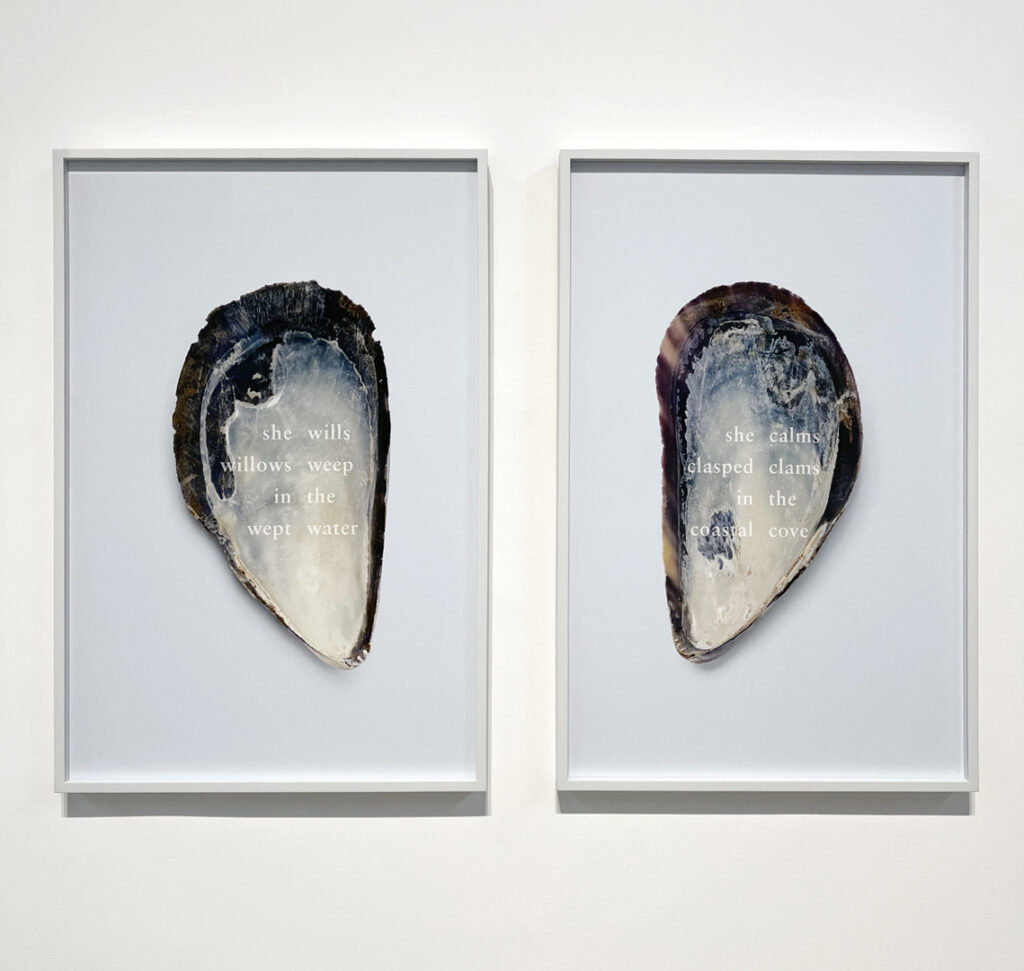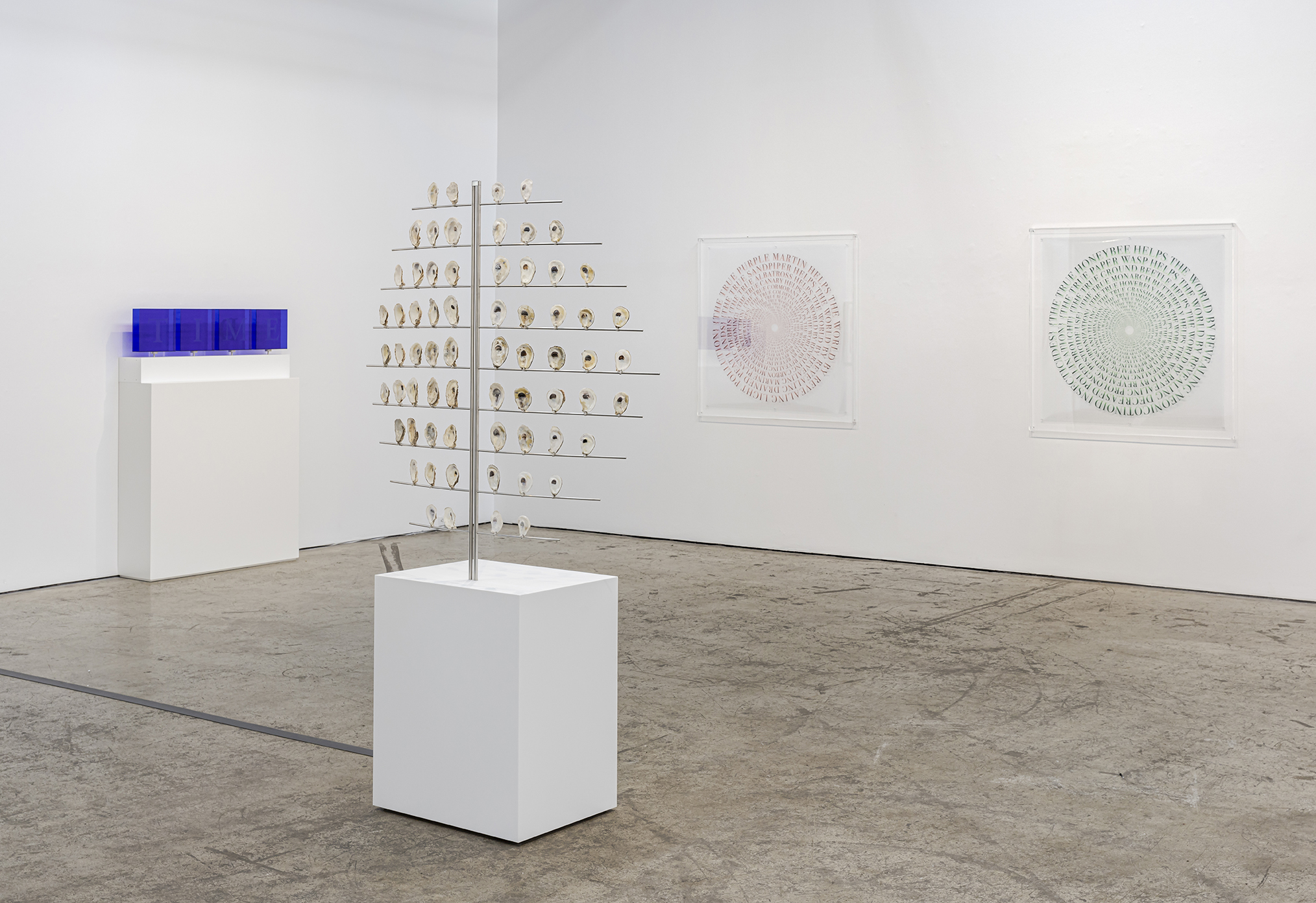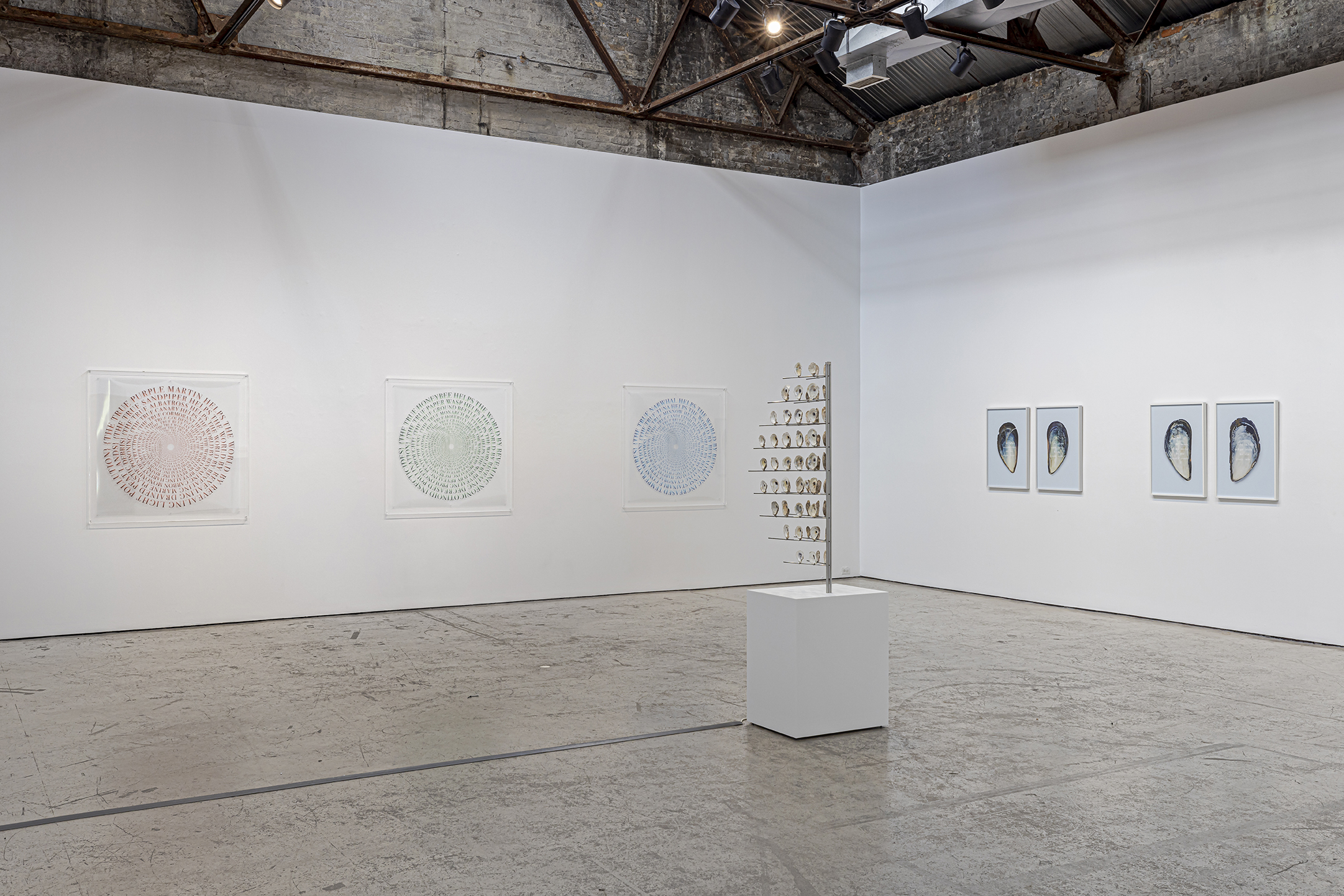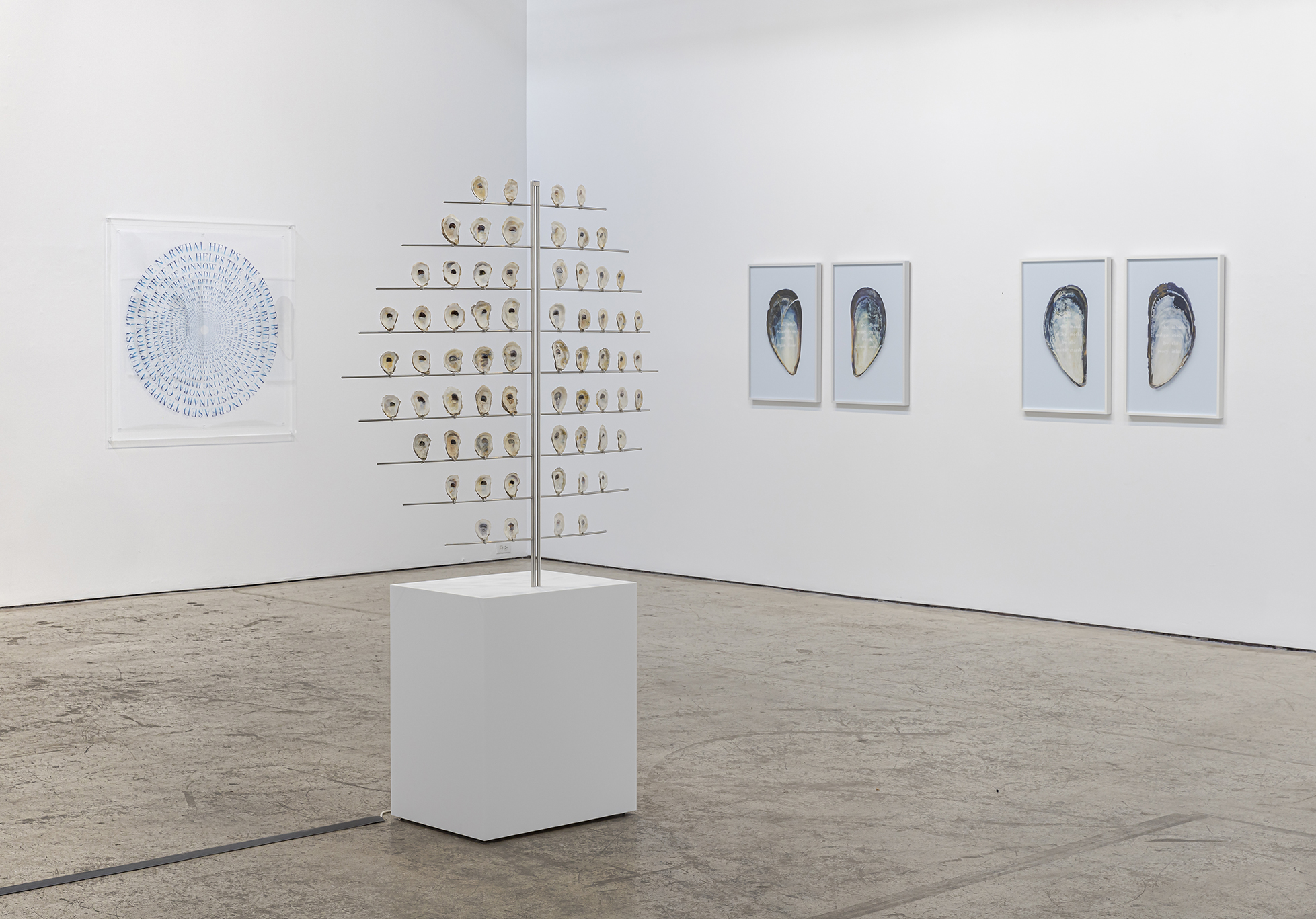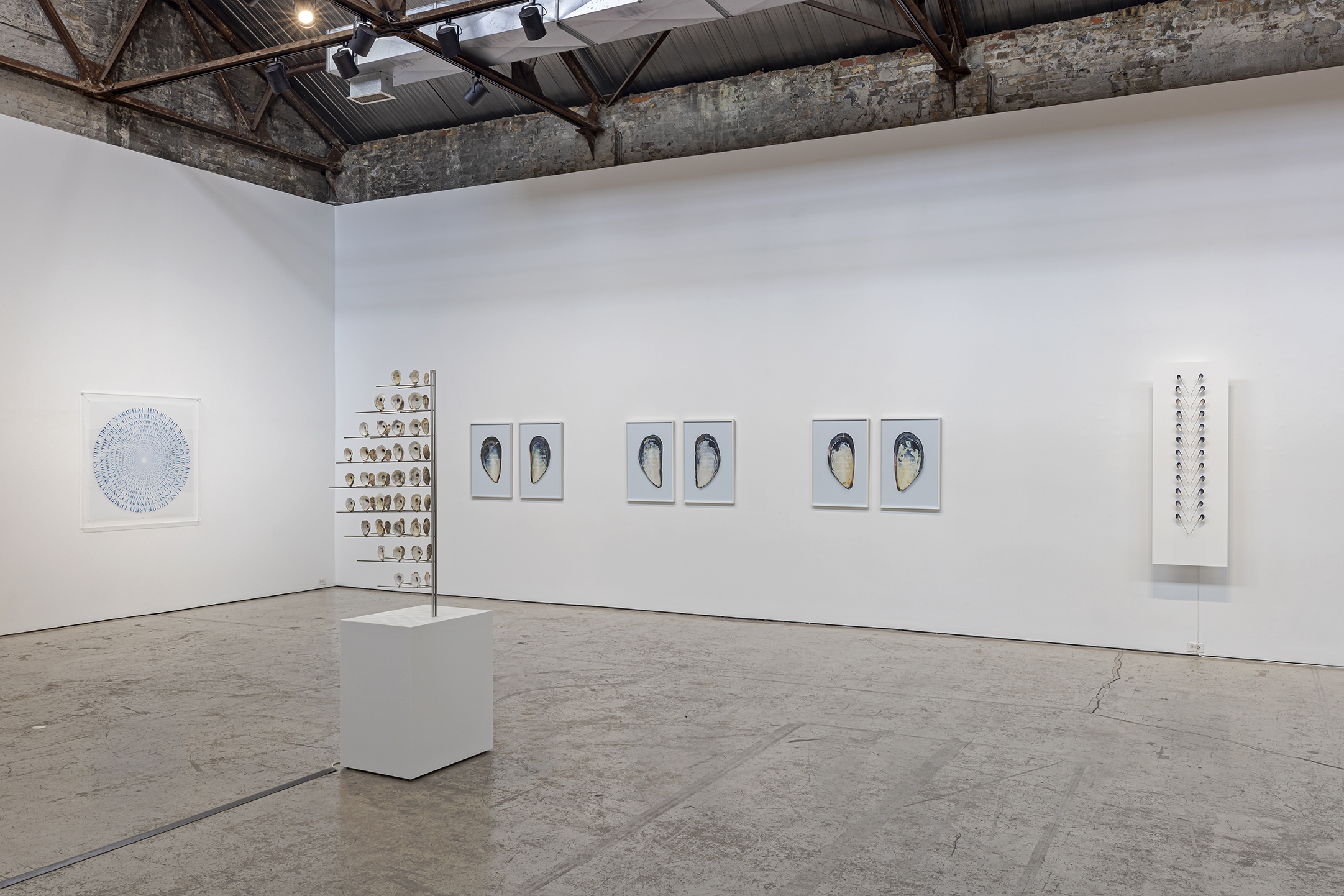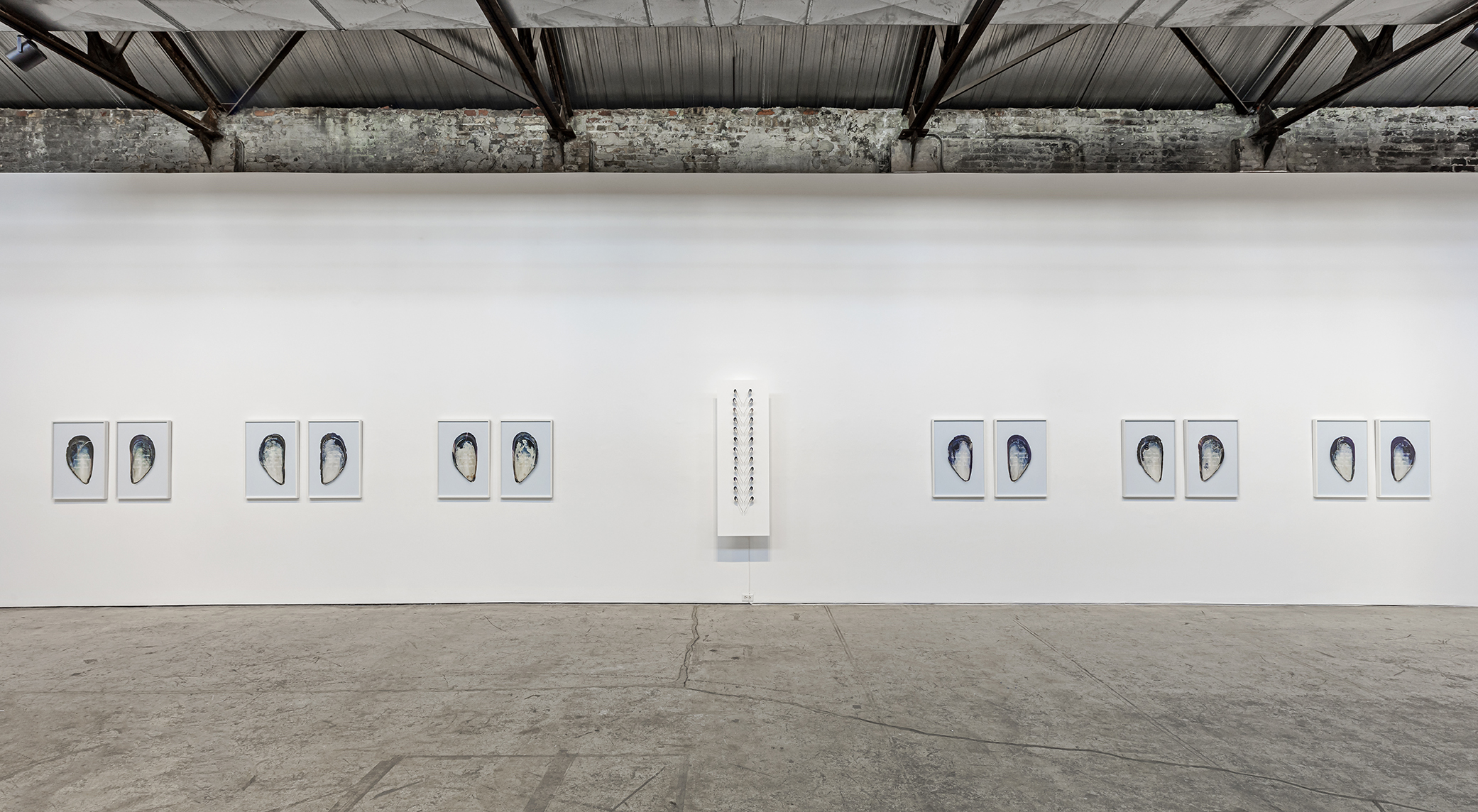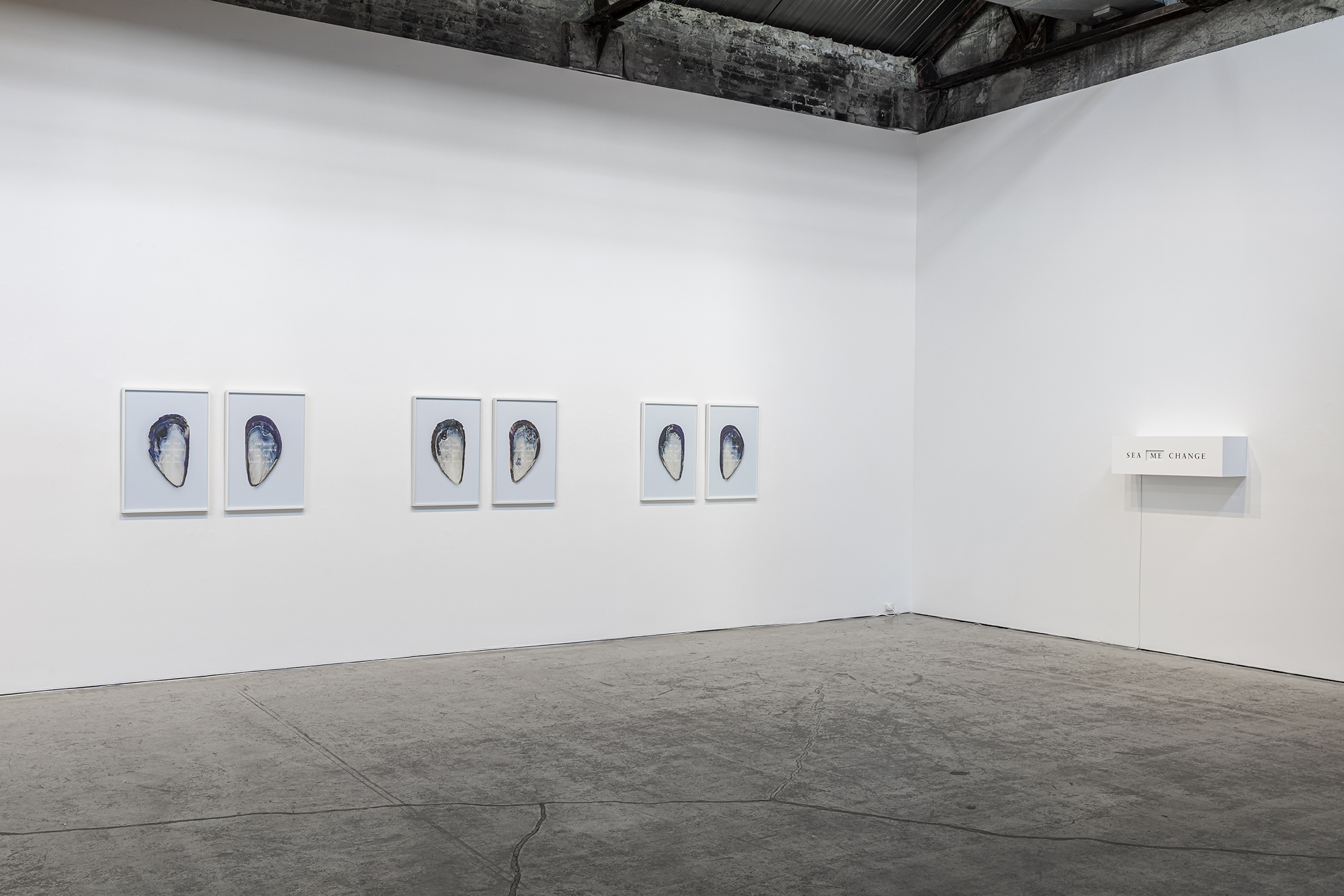lois andison
pieces of you are pieces of me
June 15 – July 20, 2024
Opening reception: Saturday June 15, 2 – 5 pm
Artist Talk: Saturday July 6, 2 pm
Oysters and mussels are fascinating creatures. They belong to mollusk phylum [group] of invertebrate which includes up to 76,000 known species. Each in their own way, the two species are key to marine and freshwater ecosystems as they filter water and C02, create and support reef architecture, protect from invasive animals, and provide habitat to other water creatures. I must admit that I was never drawn to learning about mussels or oysters as I was drawn to learn about other animals––those with cute faces, fluffy fur, speed, or prowess. I was not alone in my indifference as most internet search results, and various popular texts in newspapers and media about oysters and mussels contain information about their nutritional value for human consumption, not so much about their role in ecology. General public’s disinterest in the fascinating lives of these creatures is sometimes shared by scientists themselves. In their major study of bivalves, biologists Klaus Wächtler and Gerhard Bauer, muse that “Karl von Frisch,” German-Austrian zoologist and Nobel prize winner, “is reported to have turned the pages more quickly in texts where bivalves were treated because, according to him, they literally lack any behaviour.”[1] In short, even according to zoologists of von Frisch’s stature there was something plain and boring about bivalves. In contrast to von Frisch’s lack of interest, and in preparation to write this essay, I was drawn into their world and the intricate role they play in freshwater and marine life. More importantly, my fascination was primarily spurred by Lois Andison’s new show pieces of you are pieces of me in which she gives oysters and mussels their rightful place as intricately complex creatures of beauty and resilience.
As much as pieces of you are pieces of me is about bivalves, it is also about much more––it is a work of what Saidiya Hartman calls “critical fabulation,” a story of entanglement of life, its precarity and beauty.[2] Unlike Andison’s previous solo show an accumulated life (2019) which dealt with grief and the grieving process, pieces of you is about survival. It is a hopeful look at resistance to destruction, and Andison’s use of oysters and mussels as the conceptual backbone is more than fitting. pieces of you certainly offers many aspects of the artist’s recognizable conceptual tropes––emphasis on text, her poetic take on feminist theory, word play, focus on ideological structure of language and the way it constructs patriarchal discourses, analysis of seduction and beauty of language, etc. However, the precarity and vulnerability I detect in Andison’s handling of both the material and the theme is where I see some interesting new lines of departure in this new body of work.
Excavated from the artist’s garden, mussel and oyster shells were lovingly cleaned, polished, and documented. shell shield is a sculpture constructed of oysters which have been arranged in a shield-like formation. Both oysters and mussels are considered “keystone species,”[3] and “ecological engineers” because of their extraordinary impact on the habitat. [4] As such they are indispensable to coastal ecosystems, providing “shelter and refuge for other species,” and serving as a defence from water currents and invasive species.[5] The shells also protect the animal’s soft, vulnerable body: the two halves tenderly embrace giving it its bivalvial structure. Echoing this ecological function, Andison’s shell shield consists of the two hinged part shells and is equal parts strong (literally made up of shells mounted on a metal structure) and delicate. In their second life as sculptures, the oysters slowly move and breathe creating a sophisticated choreography of life. However, unlike in their natural state, in Andison’s sculptures the two species move outside their proscribed biological functions, slowly moving up and down in second life, almost like synchronized swimmers or gymnasts, and in shell shield they move in unison as if part of a large set of lungs.
Far from objectifying her materials, Andison painstakingly works with the shells through a meticulous and thoughtful process, in some instances bending to their will (coming up with elaborate and complicated ways to work with the fragile material to retain its natural characteristics). The artist acquiesced that she could not create a certain kind of work as the material would not let her. Both the shells and the accompanying kinetic system that makes the sculpture move, rest on an intricate equilibrium of moving parts, electromotors, sensors, and software. Therefore, just like in nature, shell shield and second life are sensitive ecosystems resting on a balance between interconnected parts which live in a symbiotic relationship. Anything can go wrong at any time: machine parts could stop working, sensors could refuse to obey the software, and shells could move out of place. Precarity abounds. Yet, this mirroring of fragile natural processes in a complex artistic system points to how vulnerability is also nature’s greatest strength. It is because relationships in nature are so precarious that its various elements – flora, fauna, organic and inorganic materials, and of course humans – must rely on each other to survive, they are what physicist Karen Barad calls entangled: “To be entangled is not simply to be intertwined with another, as in the joining of separate entities, but to lack an independent, self-contained existence. Existence is not an individual affair. Individuals do not pre-exist their interactions.”[6] Nature is beautiful because it is entangled, precarious, difficult, imperfect, and even harsh. pieces of you are pieces of me as the title of the show therefore echoes Barad’s theory of entangled intra-relating, in which all forms of life, including human, immerge, “through and as part of their entangled intra-relating.”[7] Artist’s choice to risk her own vulnerability, to create work that depends on entanglement and chances possible breakdown, is precisely why this show speaks so powerfully about the need to let go of our species’ will to dominate.
In other works, Andison repeats natural patterns and formations––spirals, circles, ovals, with earth tones, cobalt blues, and emerald greens). Even in pieces such as time/tide/id/me where a geometric, sleek square letters spin creating new meanings from the initial word ‘time’, the slow spin and their cobalt blue is reminiscent of water and its movement. The nod to the organic (in colours, movements, and shapes) repeats throughout. In the series of three prints entitled the true bird helps the world (r); the true insect helps the world (g); the true fish/mammal helps the world (b) which feature statements about the relationship of a single animal to the world, Andison reminds us that in order to survive humans need to drastically reorder our value system in which a single bee is not given any significance. Likewise, in and no birds sing (afterworks 4…Nauman, Carson) she constructs an imaginary conversation between artist Bruce Nauman and conservationist Rachel Carson. The work offers not only a critique of Bruce Nauman’s neon text piece The True Artist Helps the World by Revealing Mystic Truths (1967), but of art’s purpose in a world faced with ecological catastrophe. Echoing Rachel Carson’s book Silent Spring (1962)[8] in its title, this neon sculpture removes the mysticism of the male artist’s ego replacing it with a seemingly simple statement: “The true songbird helps the world by revealing climate change.” The challenge posed by the statement is clear: is there a need for art in a world that is falling apart? The answers are difficult yet necessary, as no human can be outside the responsibility for ecological destruction we are causing. By proposing a displacement of the subject-object (human-nature; human-animal; dominant-dominated) dichotomy and proposing that the world and nature are far more powerful, messier, and vulnerable, Andison challenges our sense of Self. Barad suggests that we are dependent; we are not single, isolated free agents, but deeply entangled beings whose lives are changed and wounded with the death of ecosystem. This rather sobering truth is revealed in pieces of you are pieces of me, however, hope is also revealed.
In 1991 an aggressive species of crab called Asian shore crab invaded the Eastern coast of US and started feasting on the native blue mussel which had no defenses against a highly skilled predator. In 2006 scientists declared that the blue mussel went through what is known as “evolution in action” and in a very short fifteen-year period of rapid change developed a thicker shell which protected it against the crab.[9] Nature is resilient, life always finds a way. Lois Andison challenges our value system, but also offers hope by showing nature’s resilient, stubborn resistance. This is what critical fabulation does at its best––it points to a way out. However, proposed solutions are not easy, they demand sacrifices, and changes. Andison asks if we can handle the kind of vulnerability and openness necessary so that pieces of you are indeed pieces of me, and the single life of a bee matters.
Essay by Bojana Videkanic
[1] Bauer, Gerhard and Klaus Wächtler eds. Ecology and Evolution of the Freshwater Mussels and Unionoida. (Berlin-Heilderberg: Springer-Verlag, 2001), v.
[2] In Hartman’s definition critical fabulation is a work of art (literature, music, visual art) that uses speculative narrative structures, and historical examples to tell stories of those who were not written in history and art, in Hartman’s case––Black histories and histories of enslaved peoples. See: Hartman, Saidiya. Wayward Lives, Beautiful Experiments: Intimate Histories of Riotous Black Girls, Troublesome Women, and Queer Radicals. (New York: W. W. Norton, 2019).
[3] Scott L Mills, Michael E. Soule, and Daniel F. Doak, “The Keystone-Species Concept in Ecology and Conservation,” BioScience, 43 (4) (1993): 219.
[4] Erin Spencer, “What’s the Difference Between Clams, Mussels, and Oysters?” Ocean Conservancy Blog, March 19, 2021. https://oceanconservancy.org/blog/2021/03/19/clams-mussels-oysters/ Last Accessed: June 4, 2024; Bayne, L. “Chapter 10 – Oysters and the Ecosystem.” Brian Bayne, ed. Developments in Aquaculture and Fisheries Science, Elsevier, Vol. 41, (2017): 703-834.
[5] Bayne, L., “Chapter 10 – Oysters and the Ecosystem,” 707.
[6] Karen Barad, Meeting the Universe Halfway: quantum physics and entanglement of matter and meaning, (Durham & London: Duke University Press, 2007), ix.
[7] Ibid.
[8] Rachel Carson, Silent Spring, (Boston: Houghton Mifflin Company, 1962).
[9] See: Reise, K., C. Buschbaum, H. Büttger, and K. M. Wegner, “Invading oysters and native mussels: from hostile takeover to compatible bedfellows.” Ecosphere 8(9) (2017): n.p.; Science News, “Mussels Evolve Quickly to Defend Against Invasive Crabs,” ScienceDaily, August 11 (2006), n.p. https://www.sciencedaily.com/releases/2006/08/060811091251.htm, Last Accessed: June 4, 2024.
Photography credit: Toni Hafkenscheid
Featured work: Lois Andison, acts of dissent, act 3, 2021, print on archival paper, ed. of 5 (diptych)
Opening Reception
June 15, 2024 2:00 pm – 5:00 pmArtist Links
Included Artworks
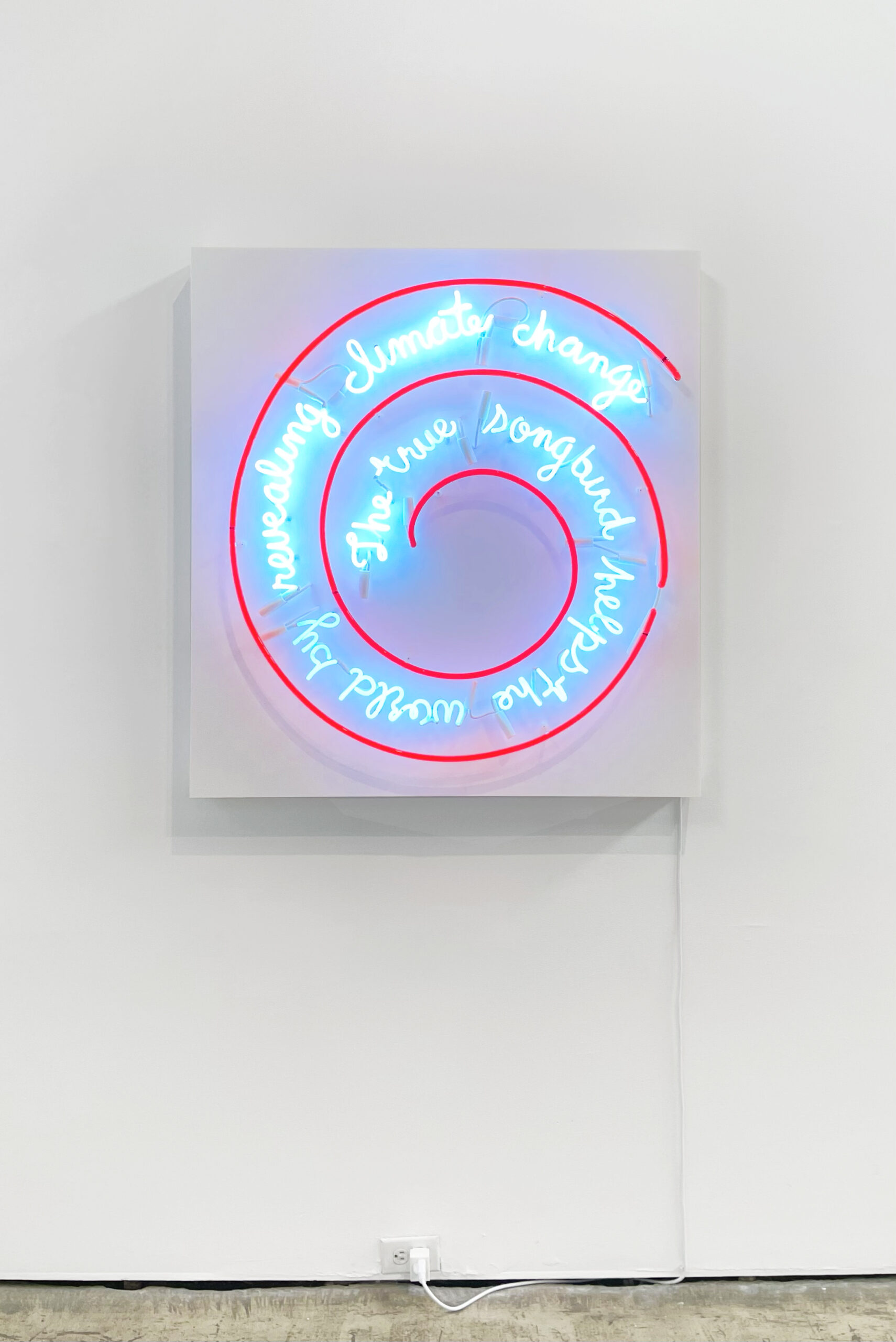
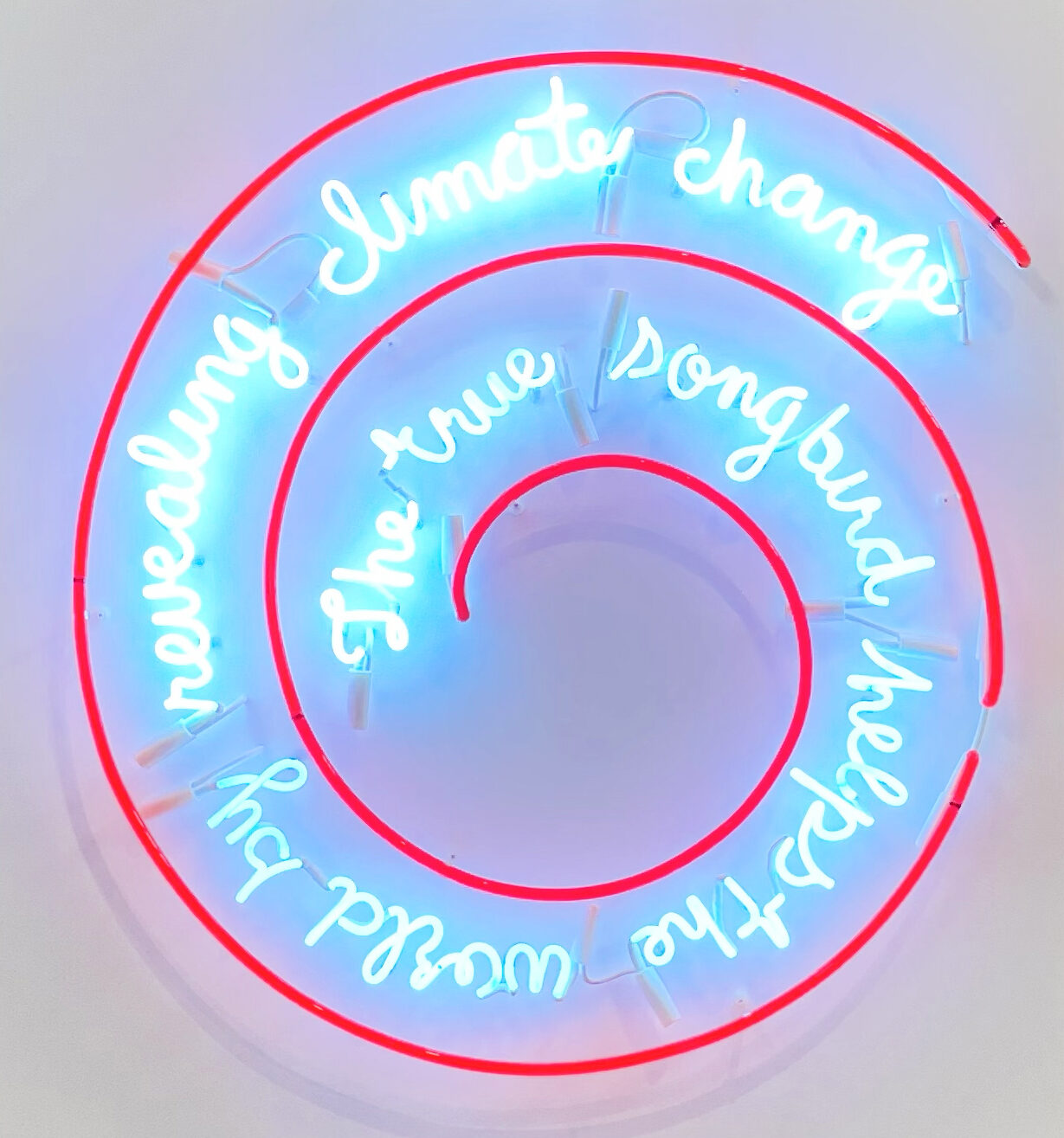
artwork detail
and no birds sing (afterworks 4... Nauman, Carson), 2024
lois andisonneon, acrylic, transformers, 39” x 42” x 4”
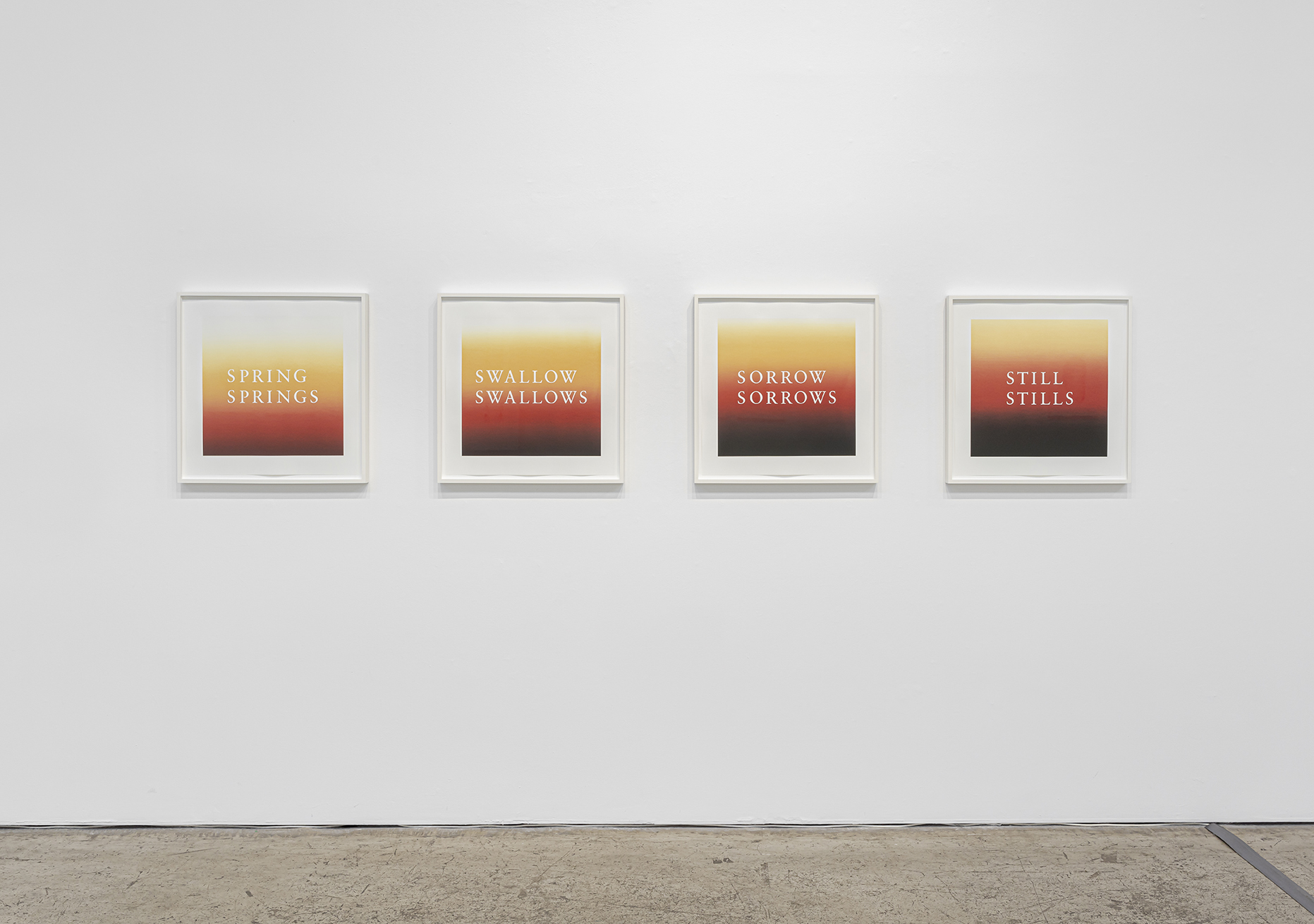
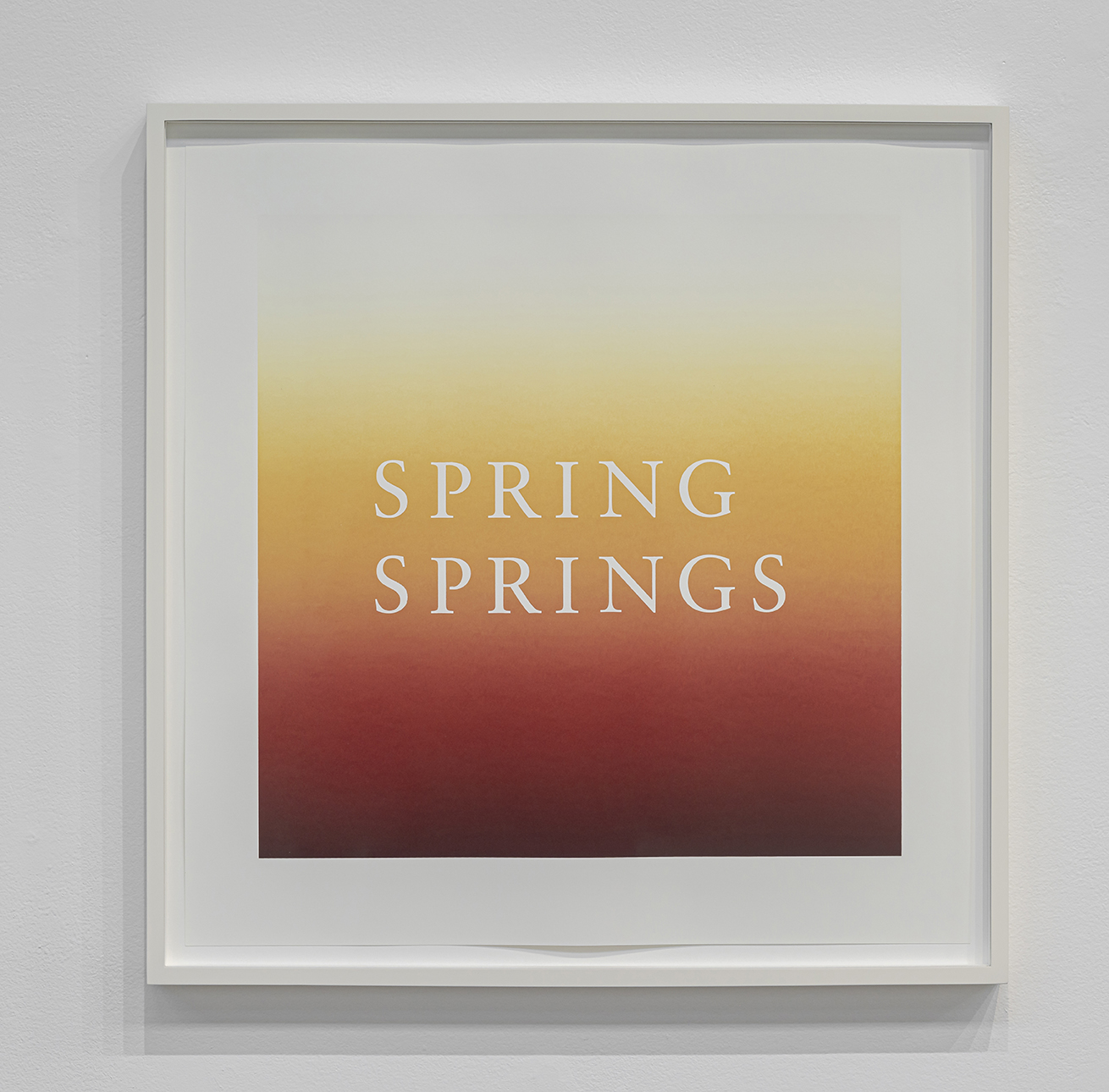
artwork detail
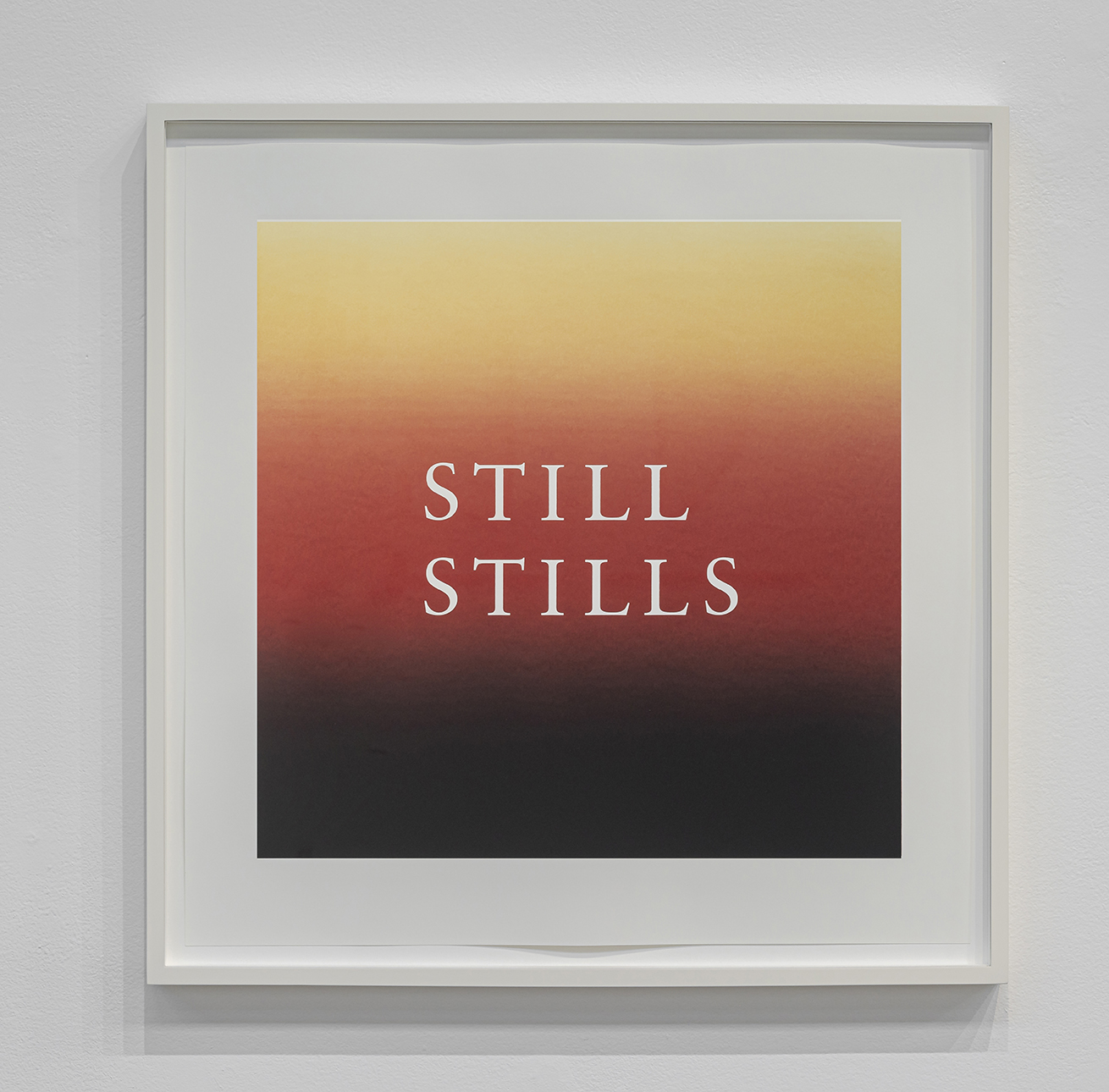
for rachel, 2024
lois andisonset of four silkscreen prints on paper, ed. of 3, AP, 22” x 22” print / 24.5” x 24.5” framed (each)
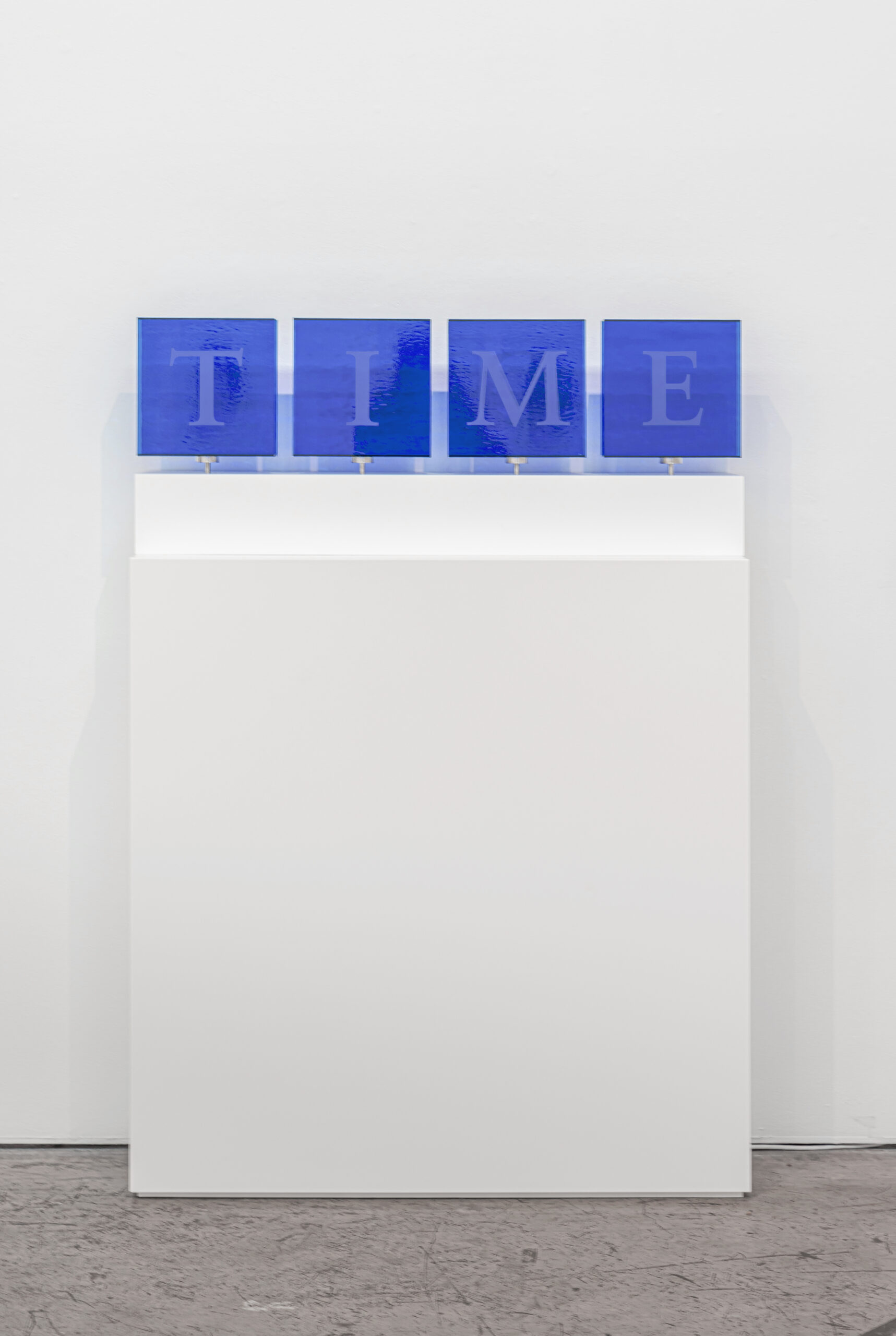
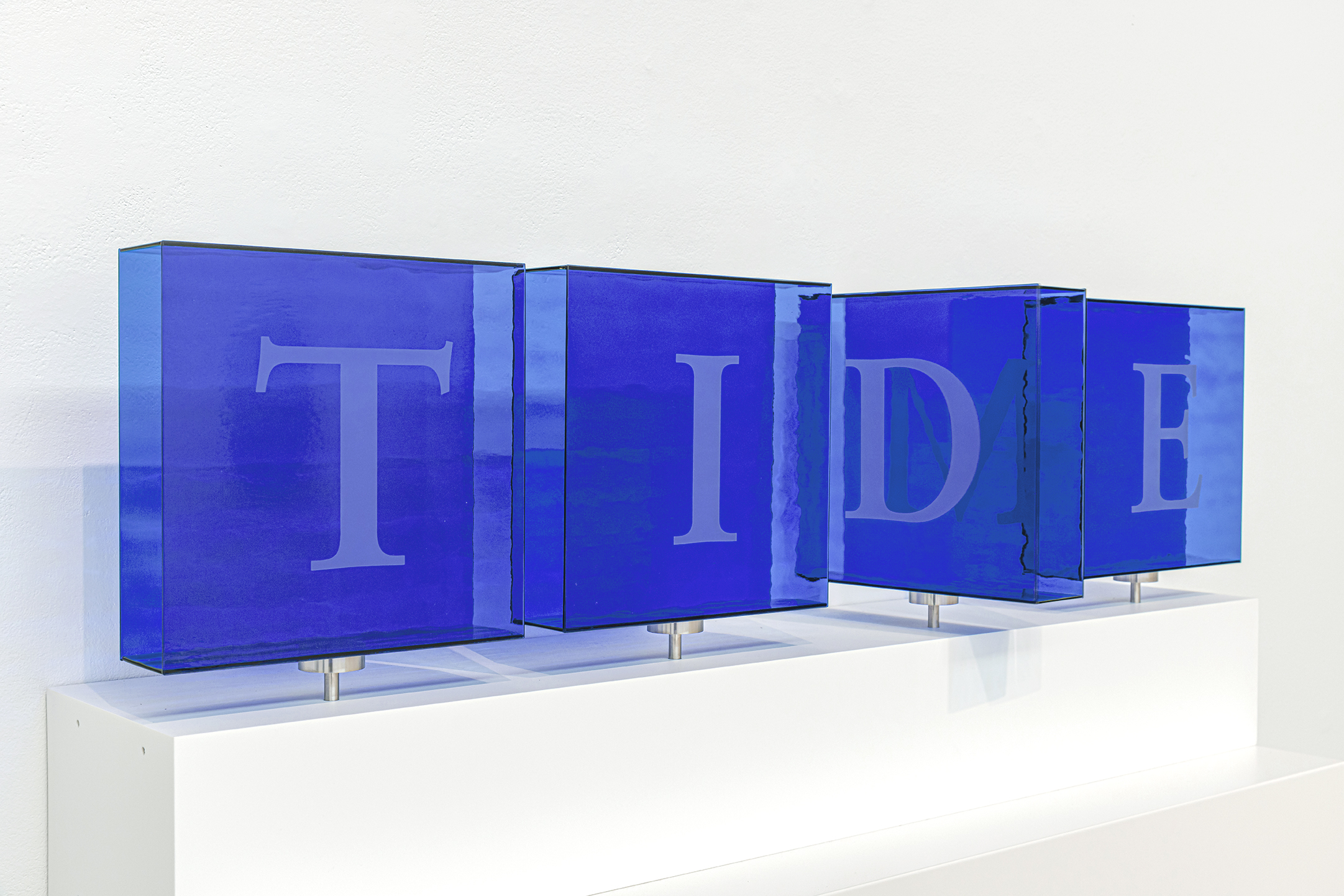
artwork detail

time/tide/id/me, 2024
lois andisonglass, stainless steel, acrylic, custom mechanics and electronics, 43.8” x 17” x 8.25”
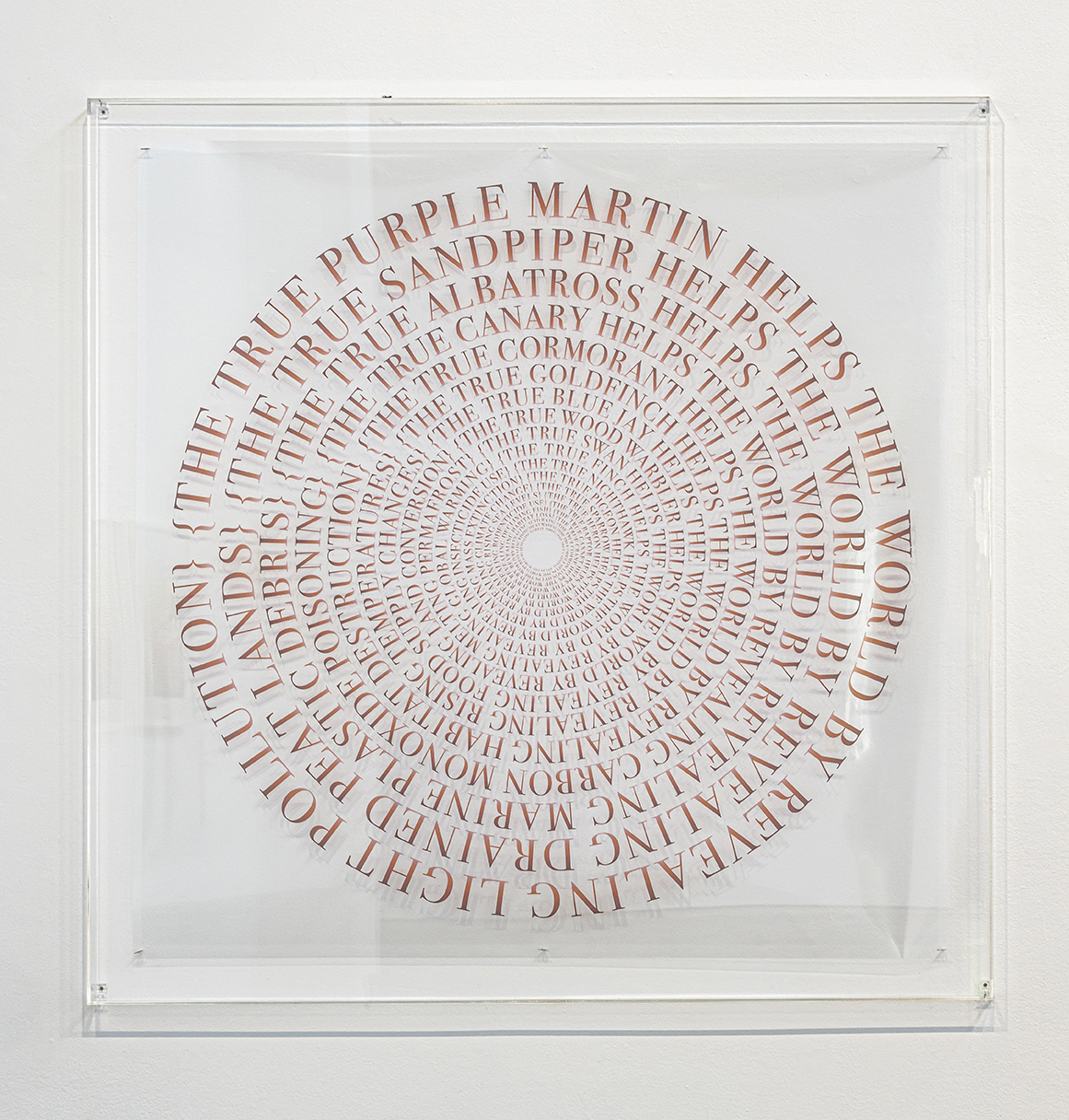
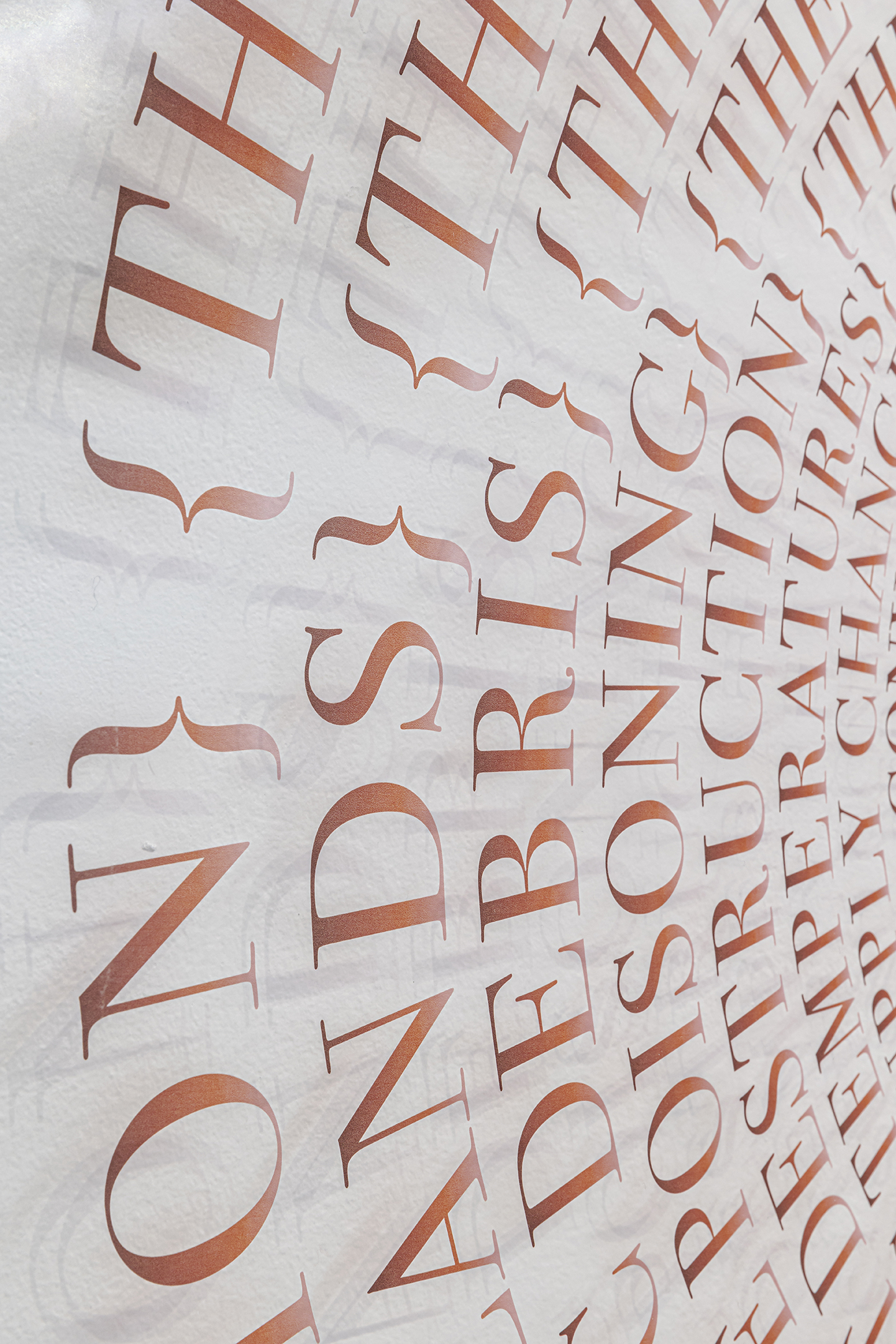
artwork detail
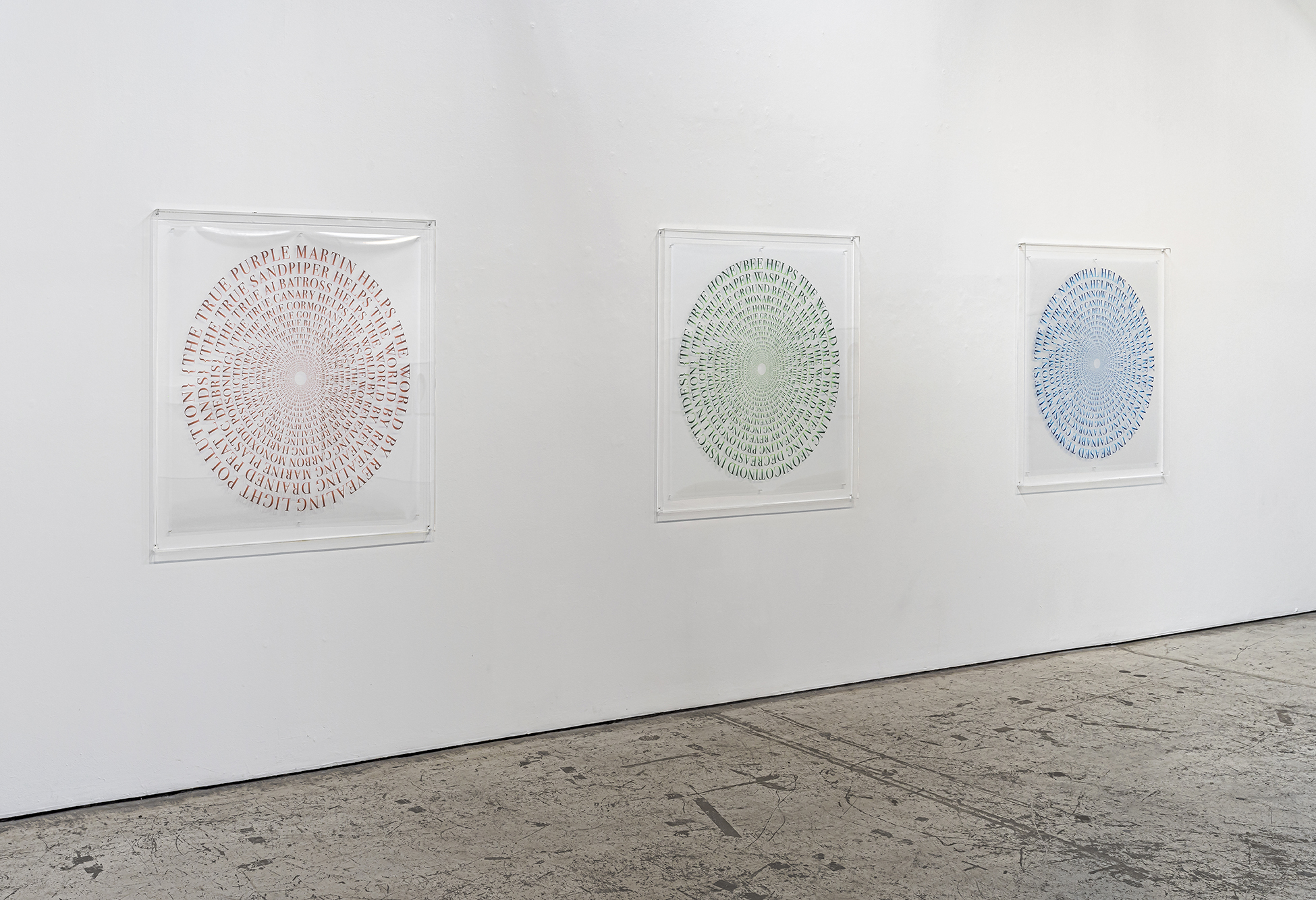
the true bird helps the world (r) (afterworks 4...Nauman, Carson), 2024
lois andisonfilm, T-pins, acrylic, 48” x 48” x 2”
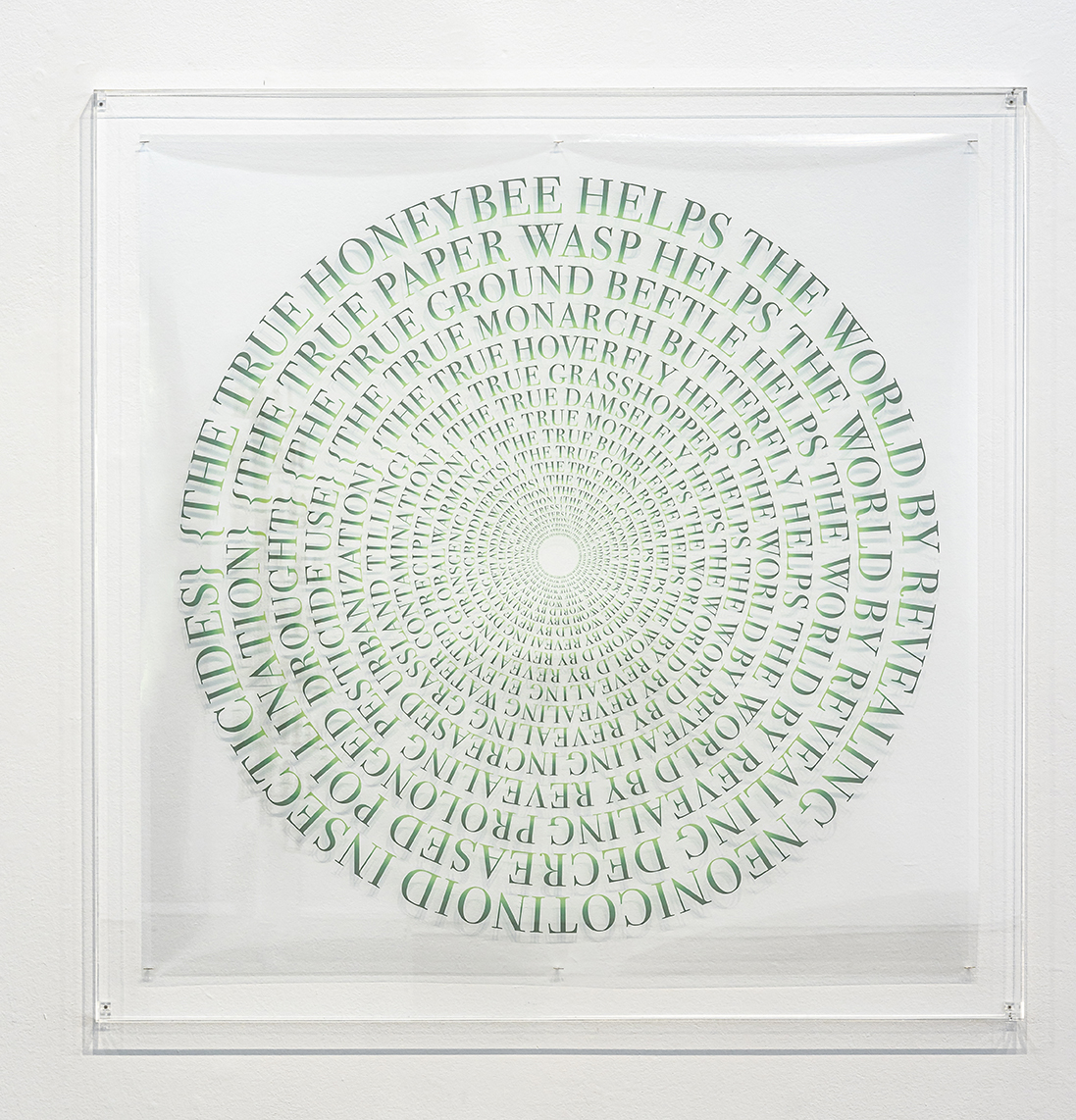
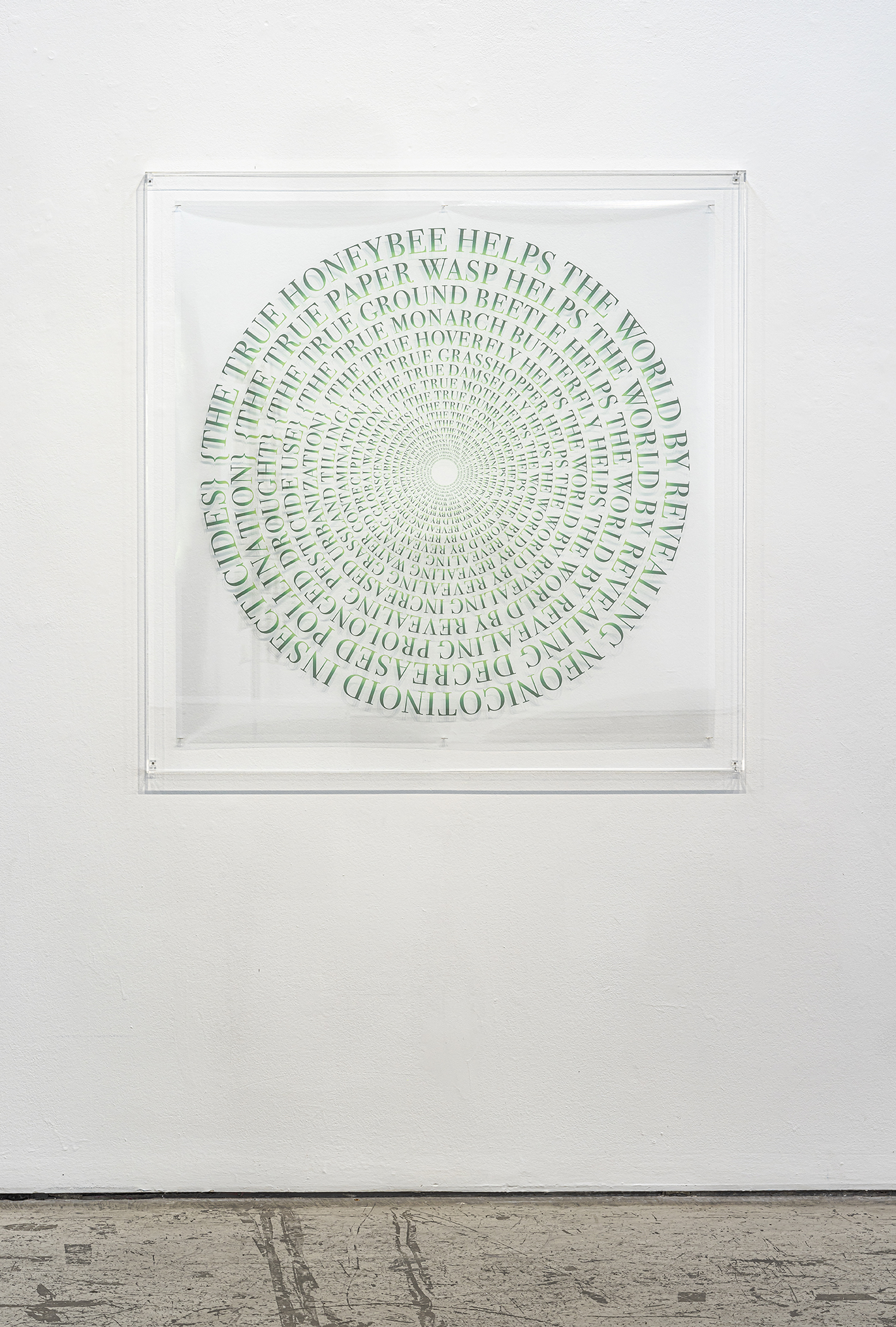
artwork detail

the true insect helps the world (g) (afterworks 4...Nauman, Carson)
lois andisonfilm, T-pins, acrylic, 48” x 48” x 2”
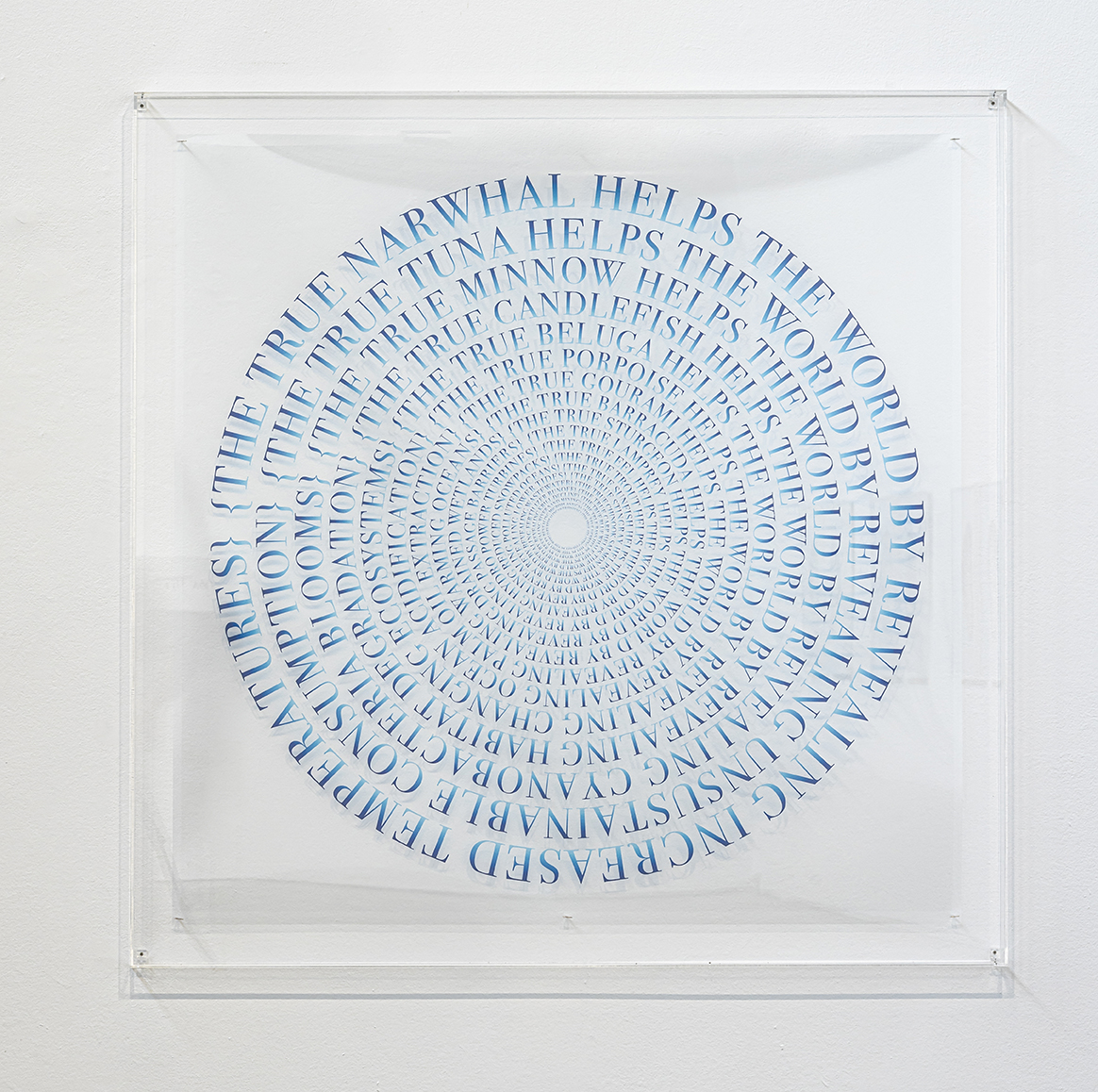
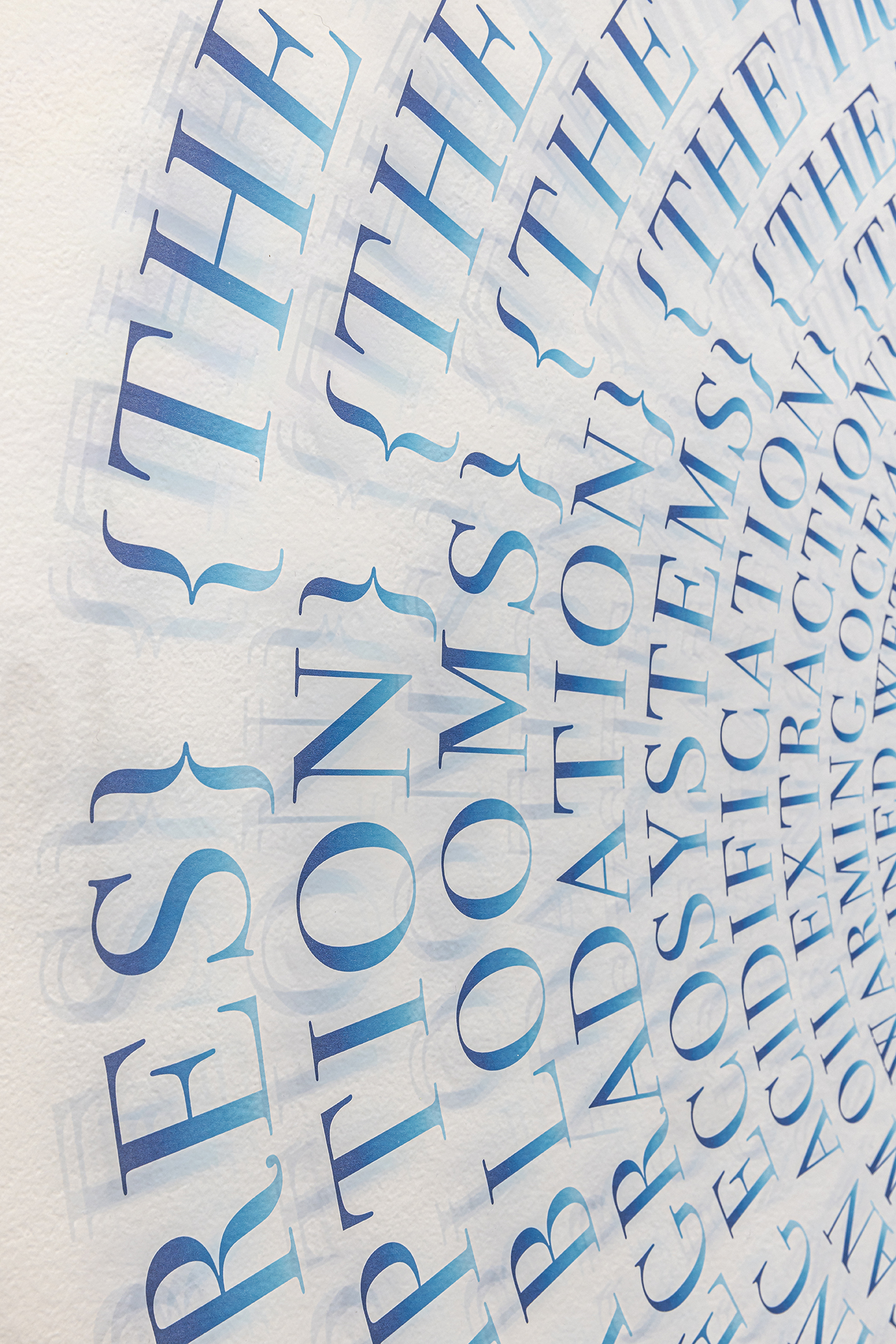
artwork detail

the true fish/mammal helps the world (b) (afterworks 4...Nauman, Carson), 2024
lois andisonfilm, T-pins, acrylic, 48” x 48” x 2”
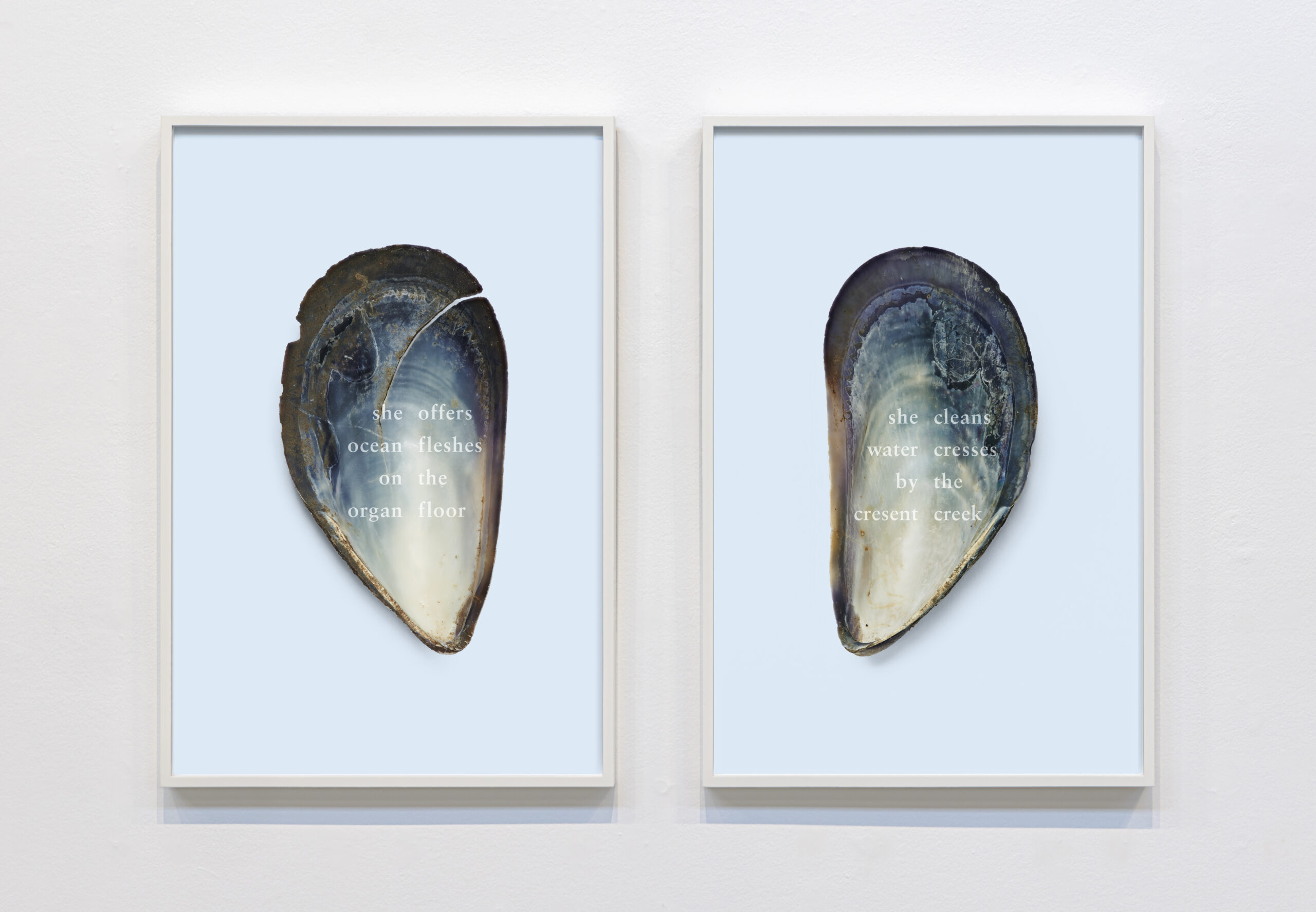
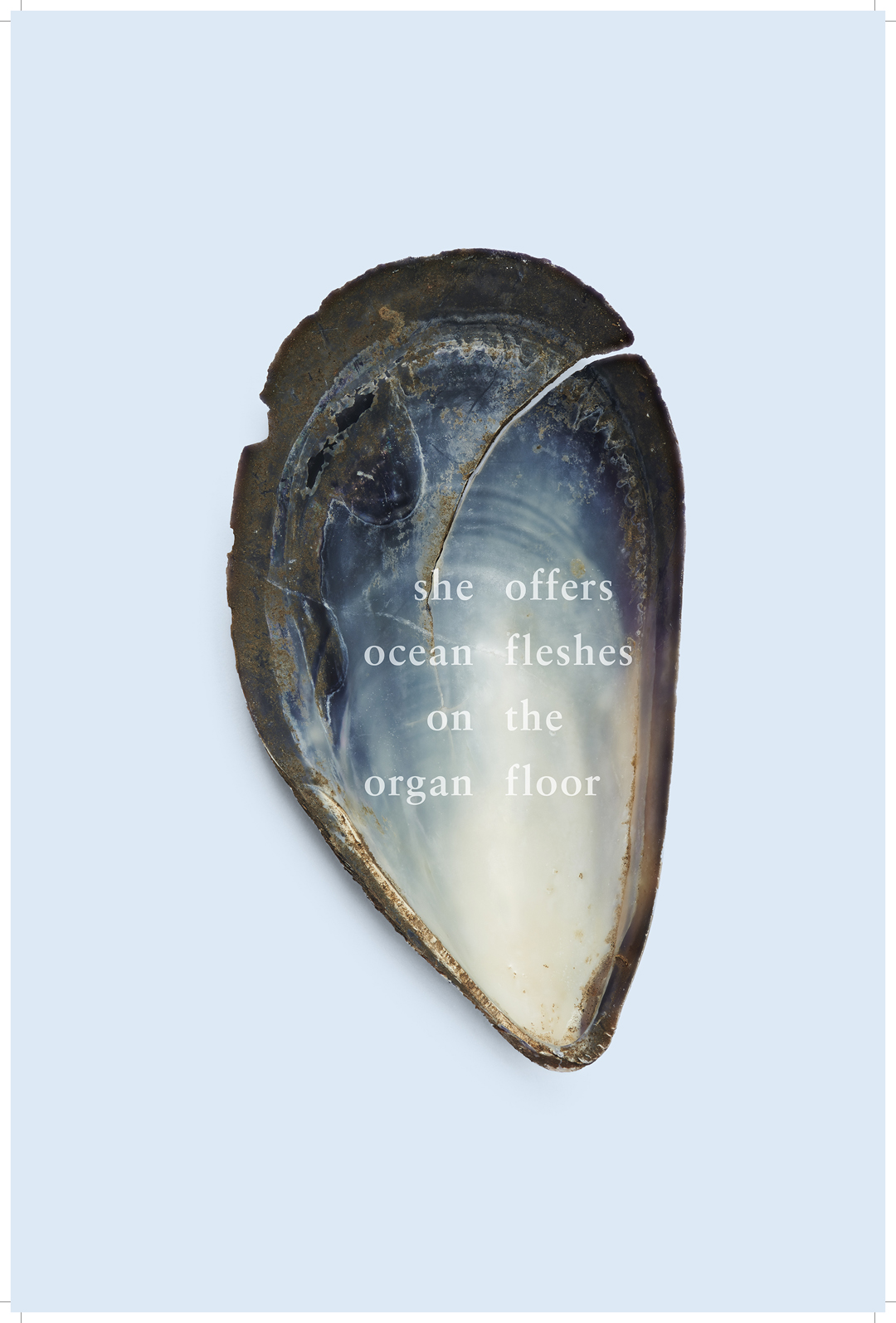
artwork detail
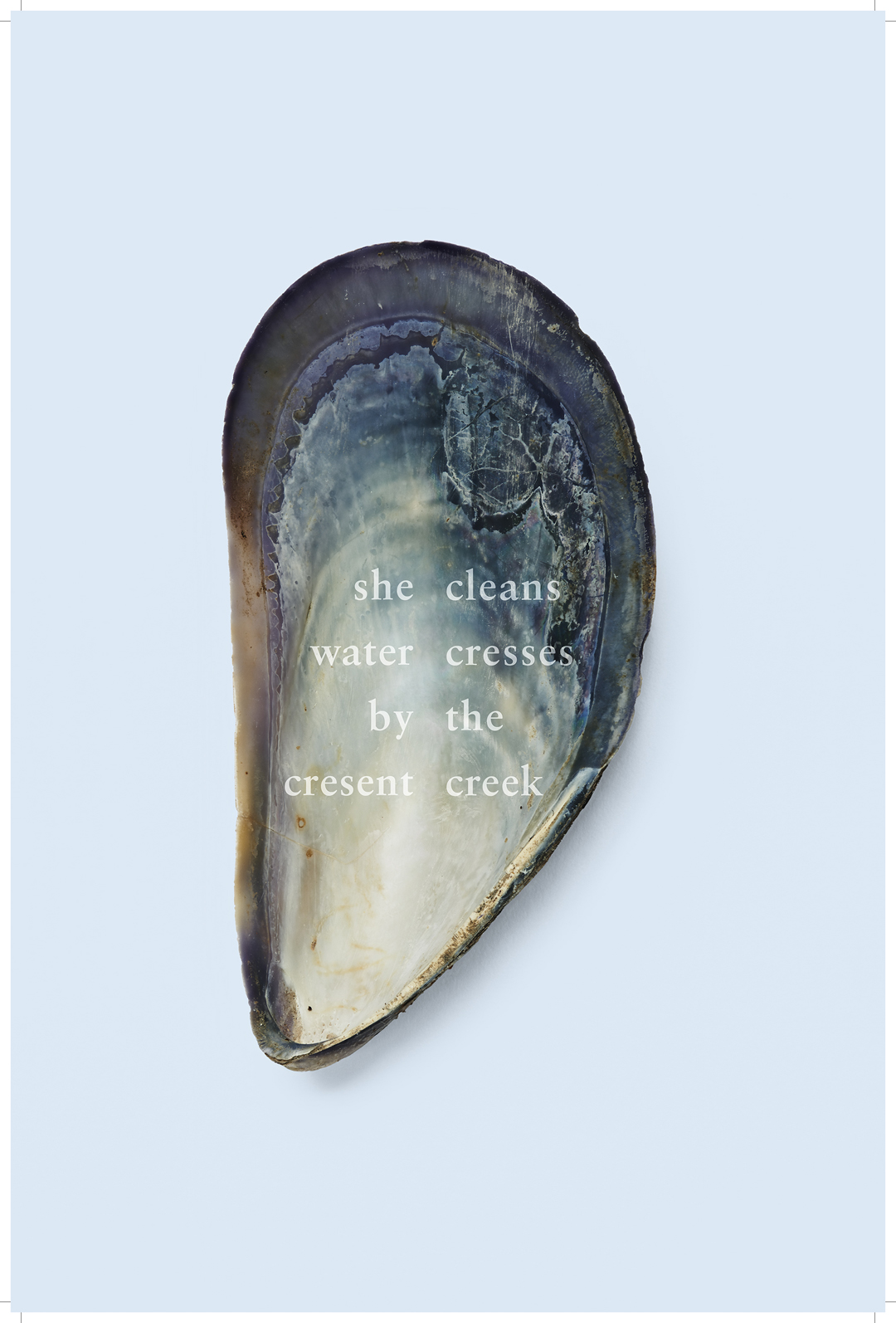
acts of dissent, act 2, 2021-2024
lois andisonfine art prints on Hahnemuehle Photo Rag 308, ed. of 5 2AP
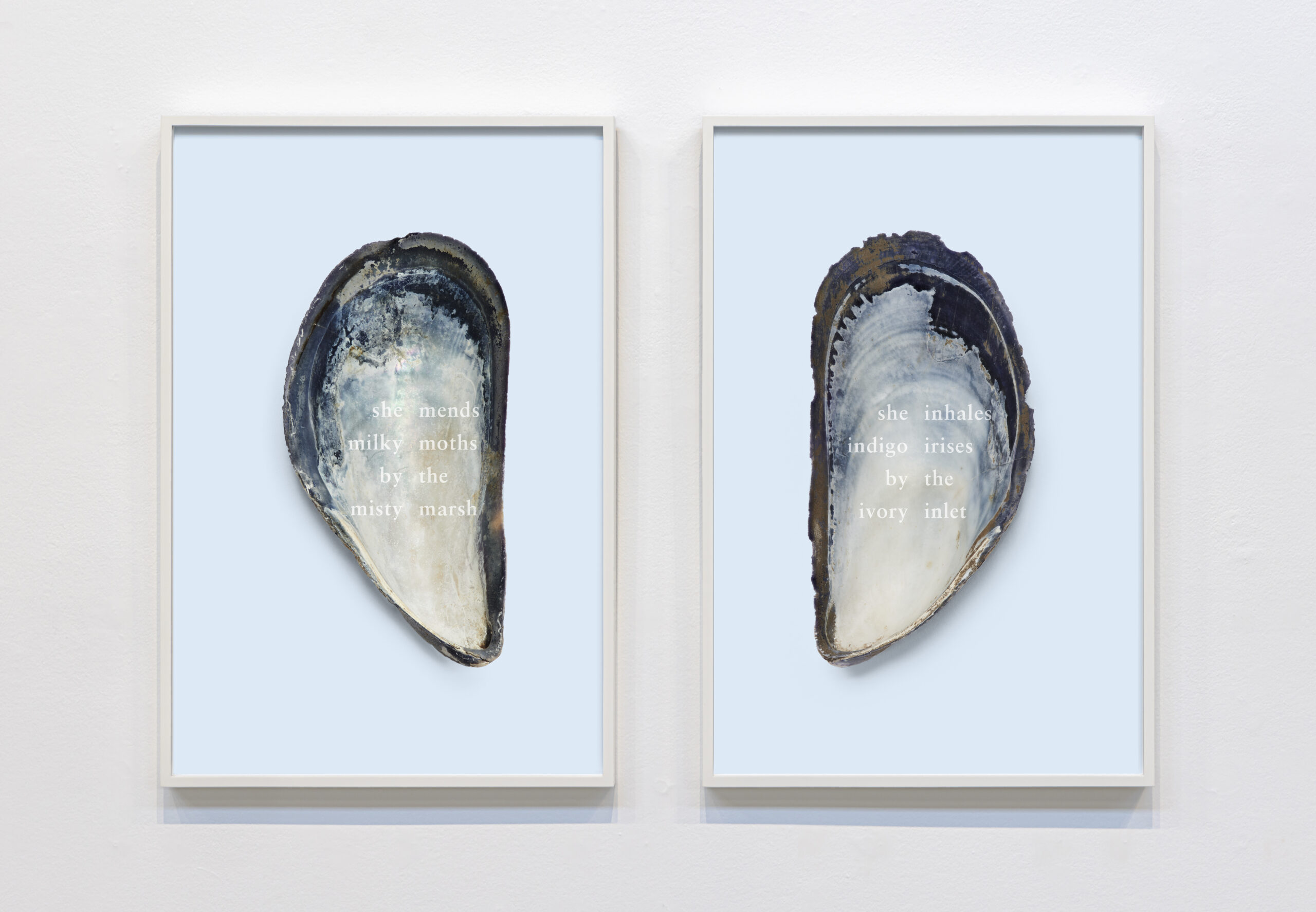
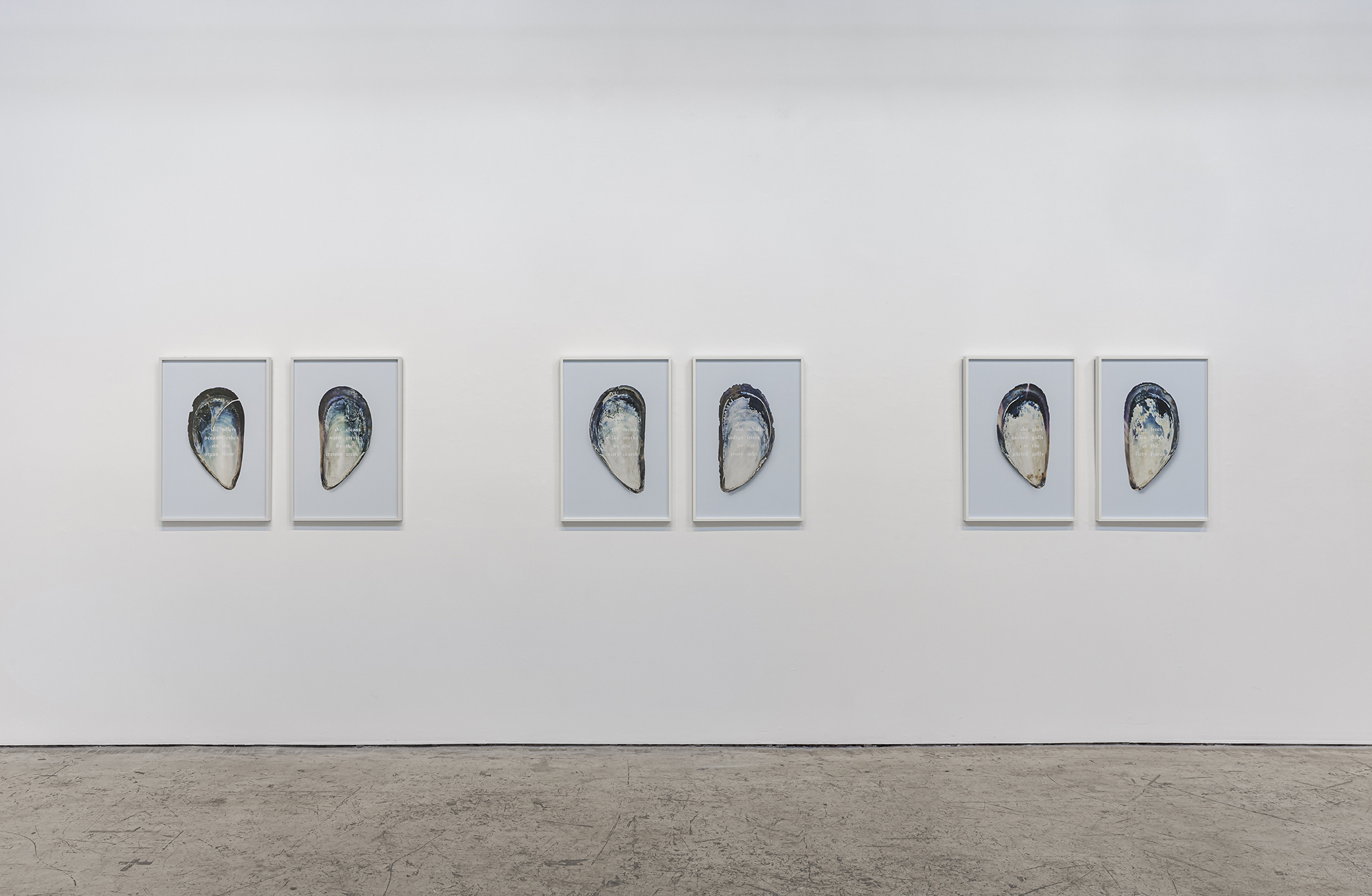
artwork detail
acts of dissent, act 5, 2021-2024
lois andisonfine art prints on Hahnemuehle Photo Rag 308, ed. of 5 2AP
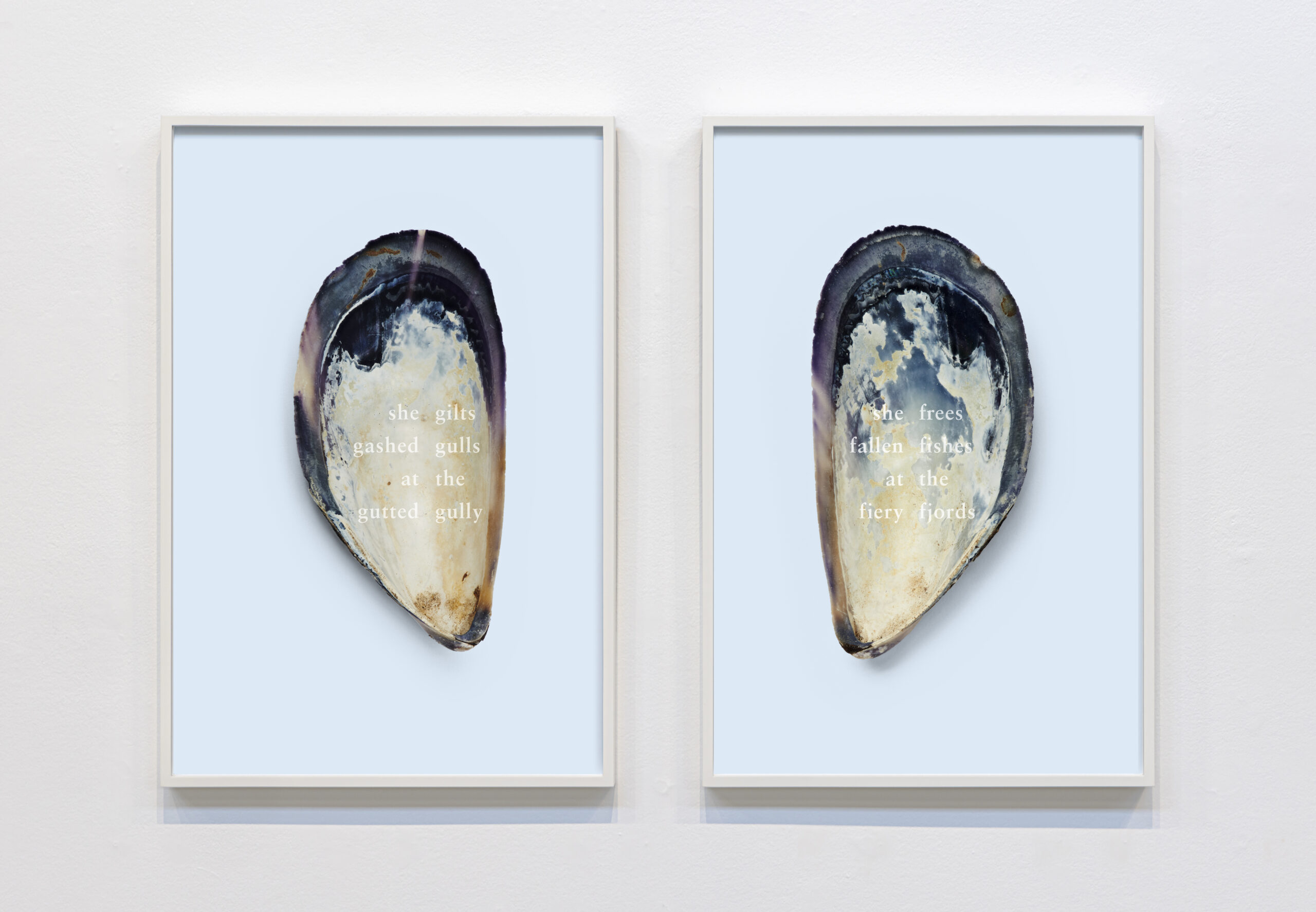

artwork detail
acts of dissent, act 6, 2021-2024
lois andisonfine art prints on Hahnemuehle Photo Rag 308, ed. of 5 2AP
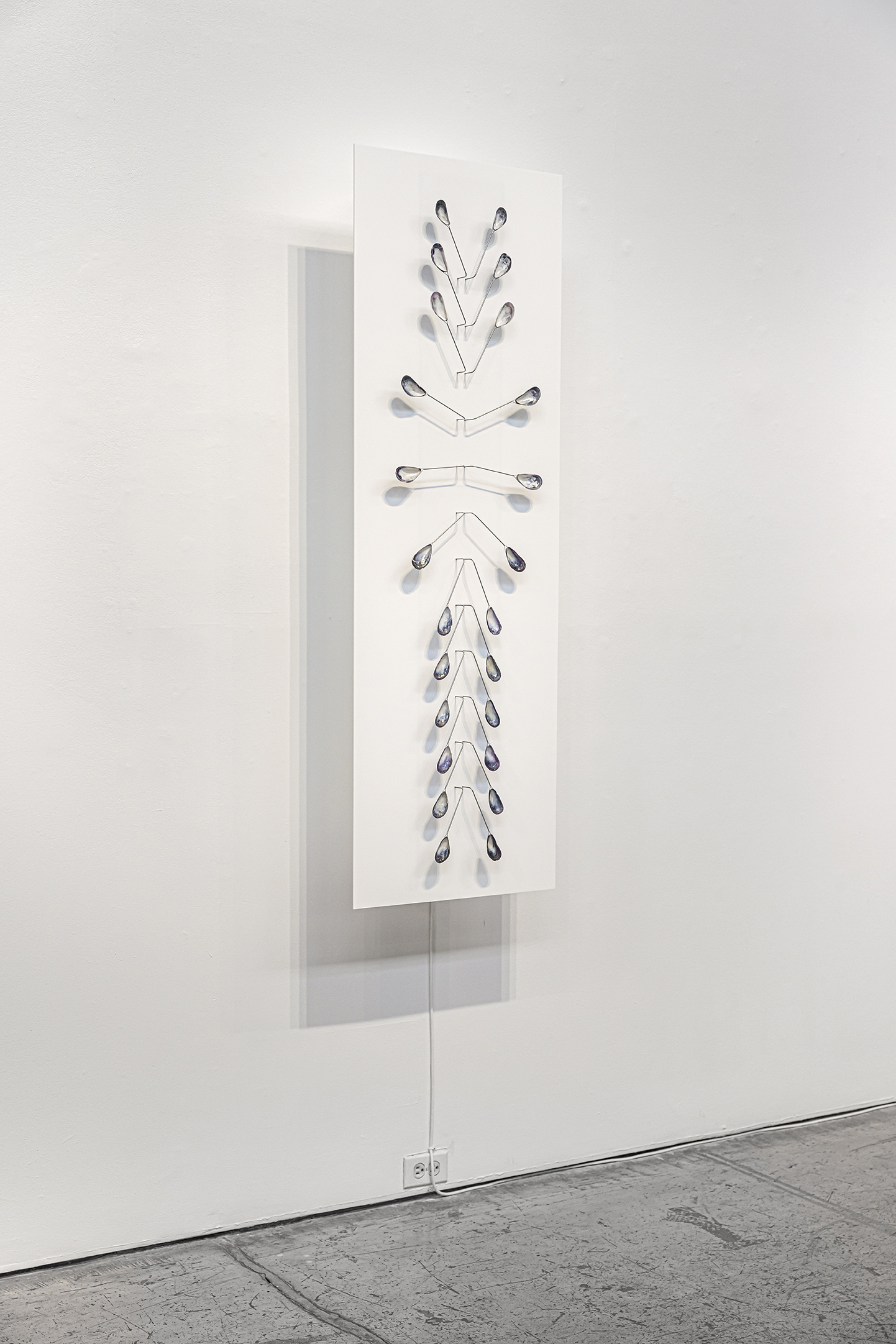
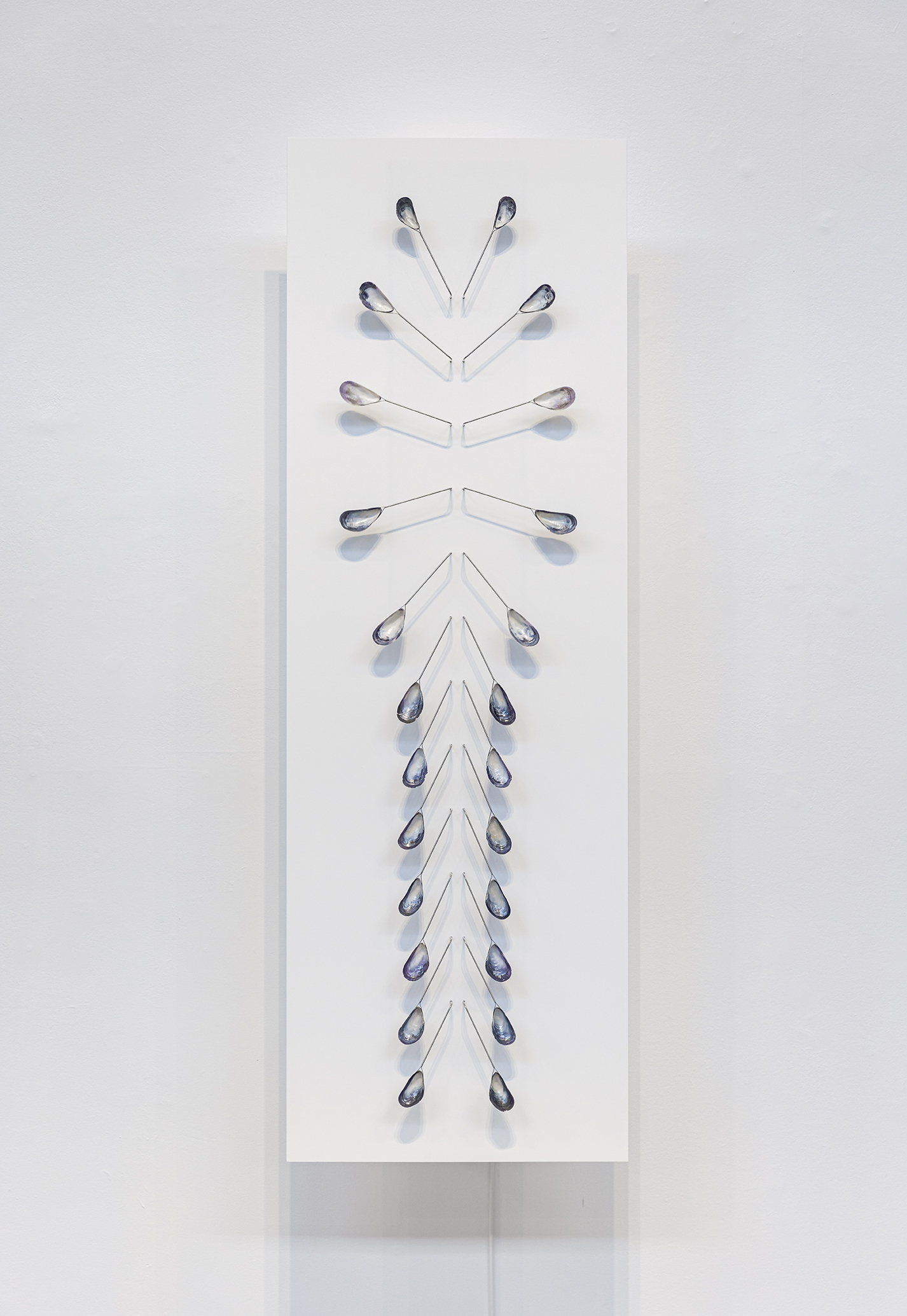
artwork detail
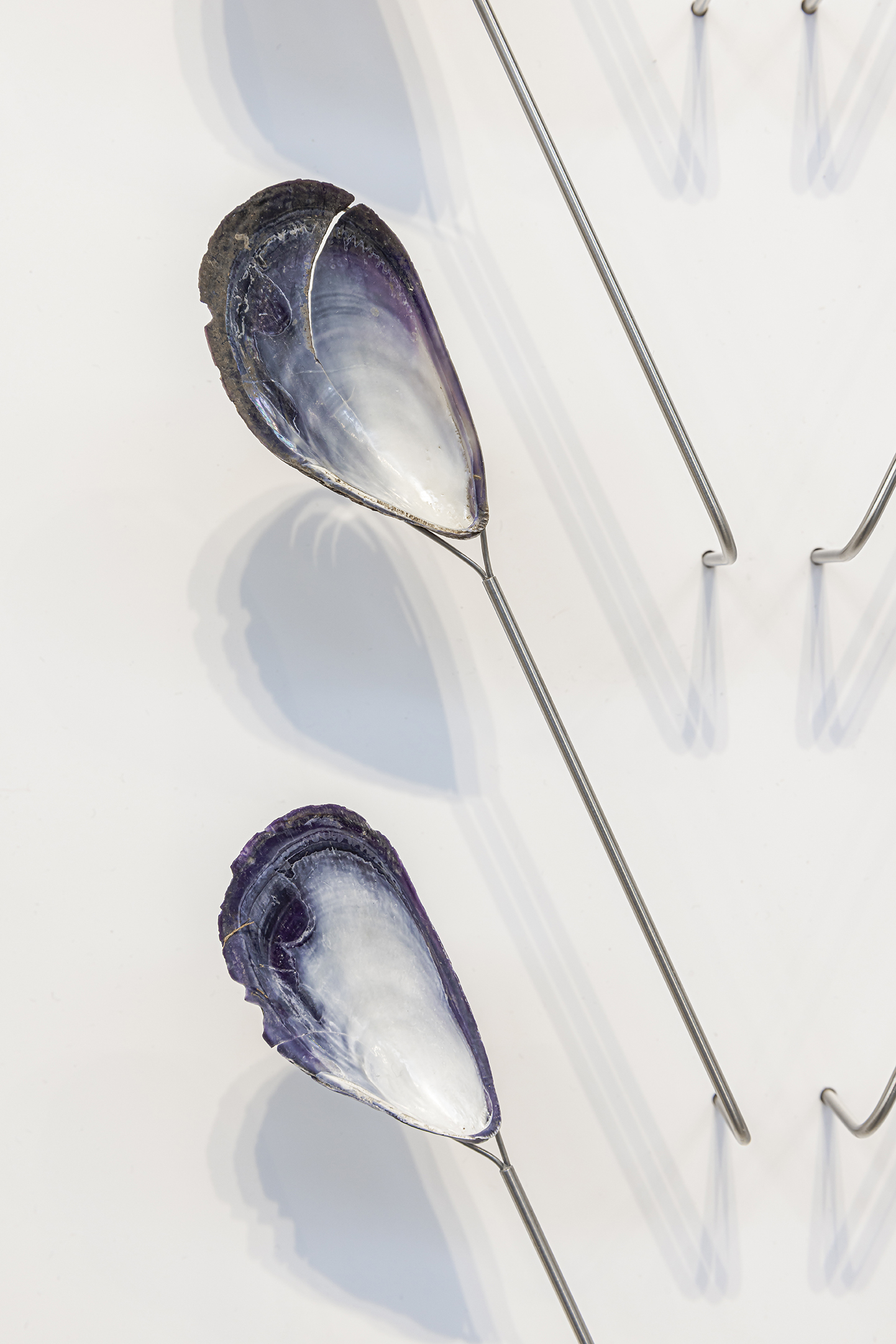
second life, 2024
lois andisonexcavated mussel shells, stainless steel arms, acrylic, custom mechanics and electronics, 20” x 60” x 7.5”
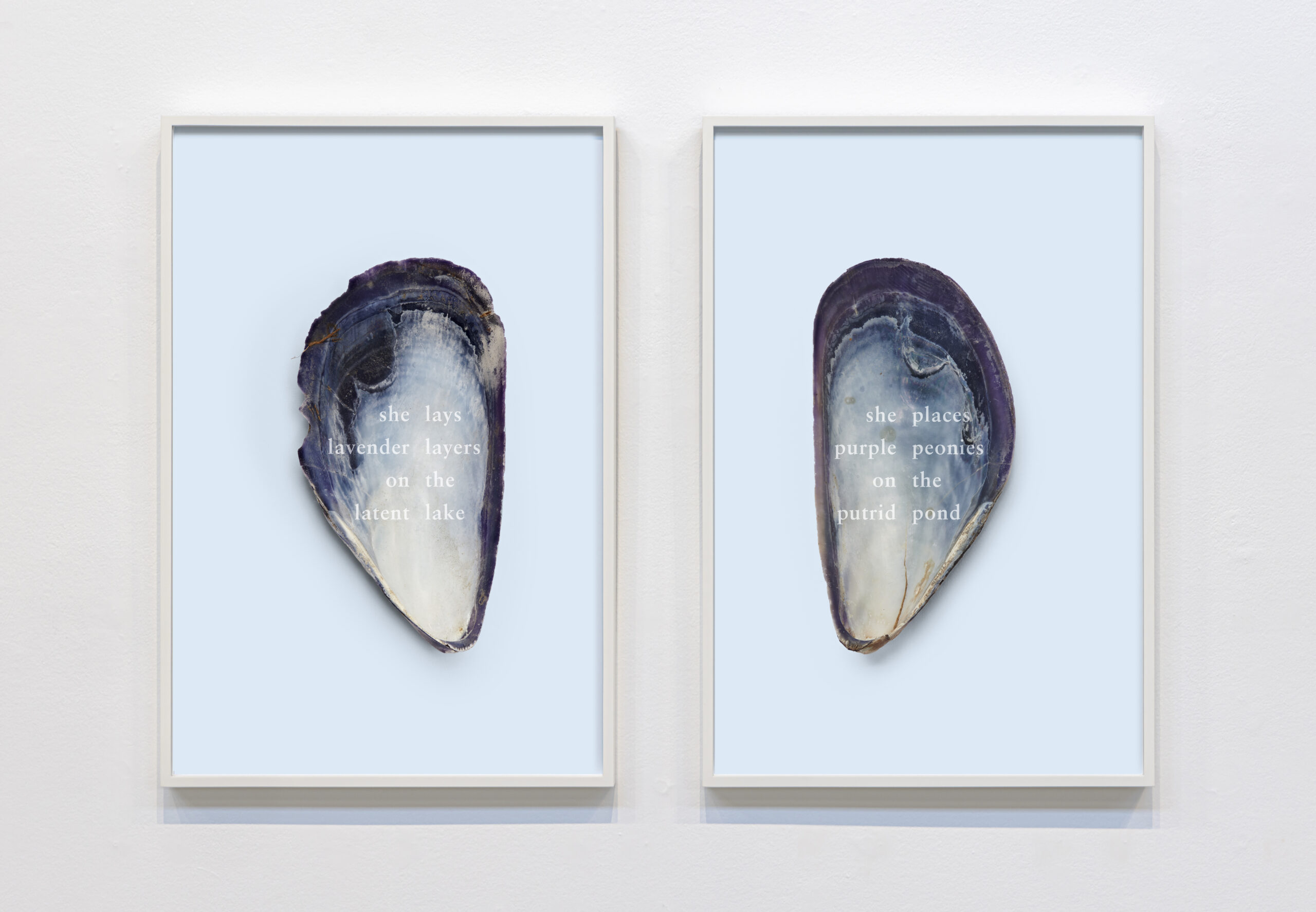

artwork detail
acts of dissent, act 7, 2021-2024
lois andisonfine art prints on Hahnemuehle Photo Rag 308, ed. of 5 2AP
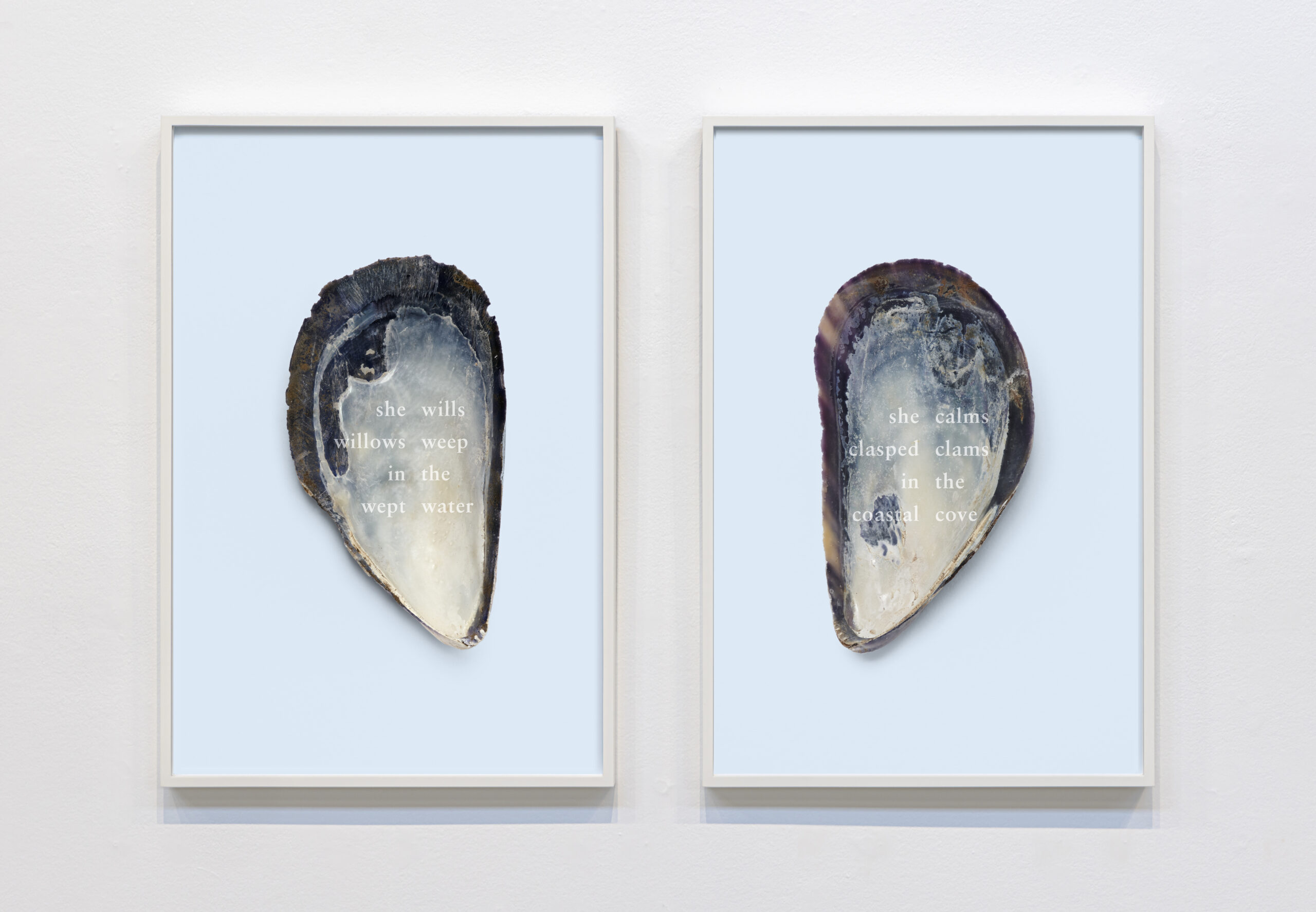
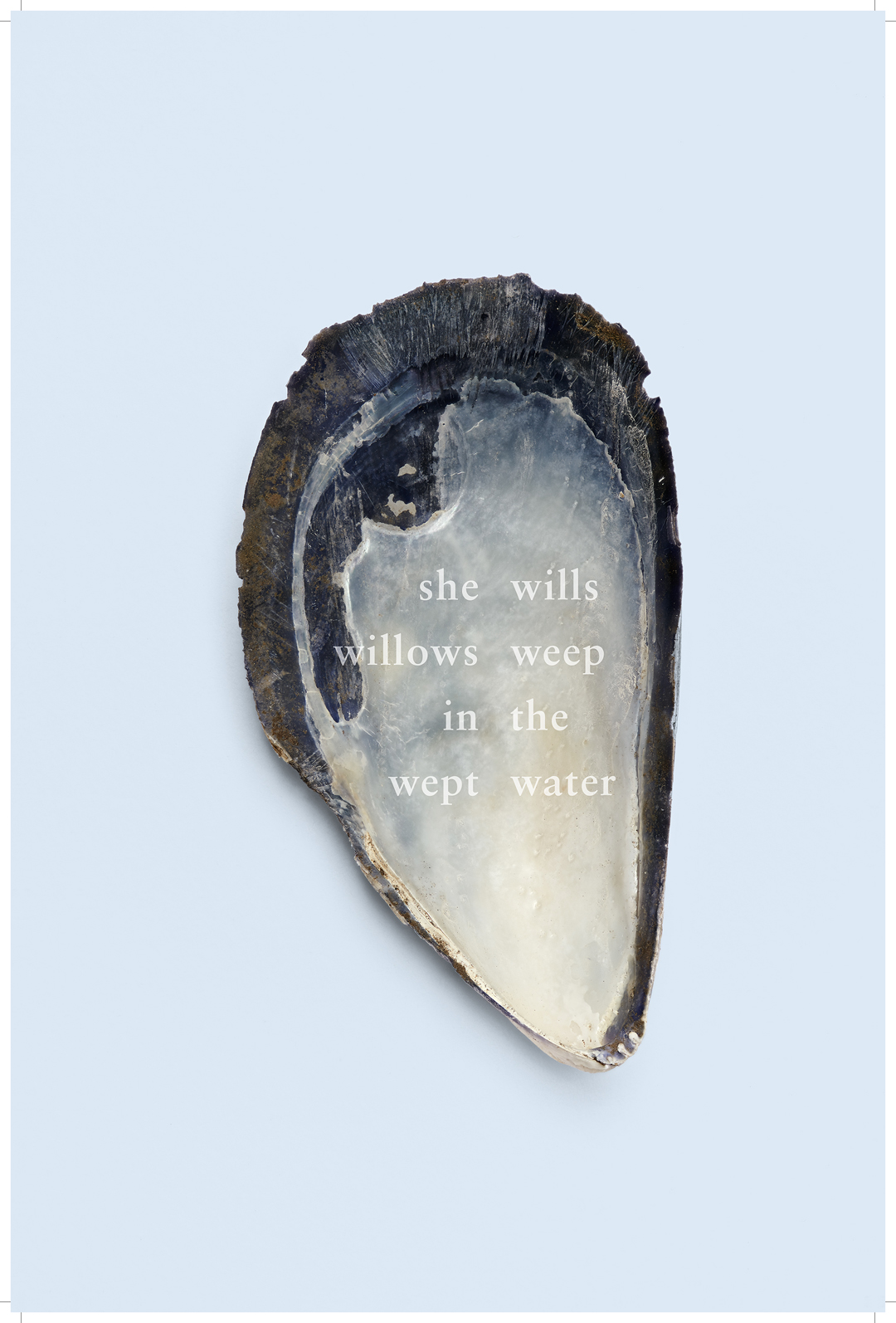
artwork detail
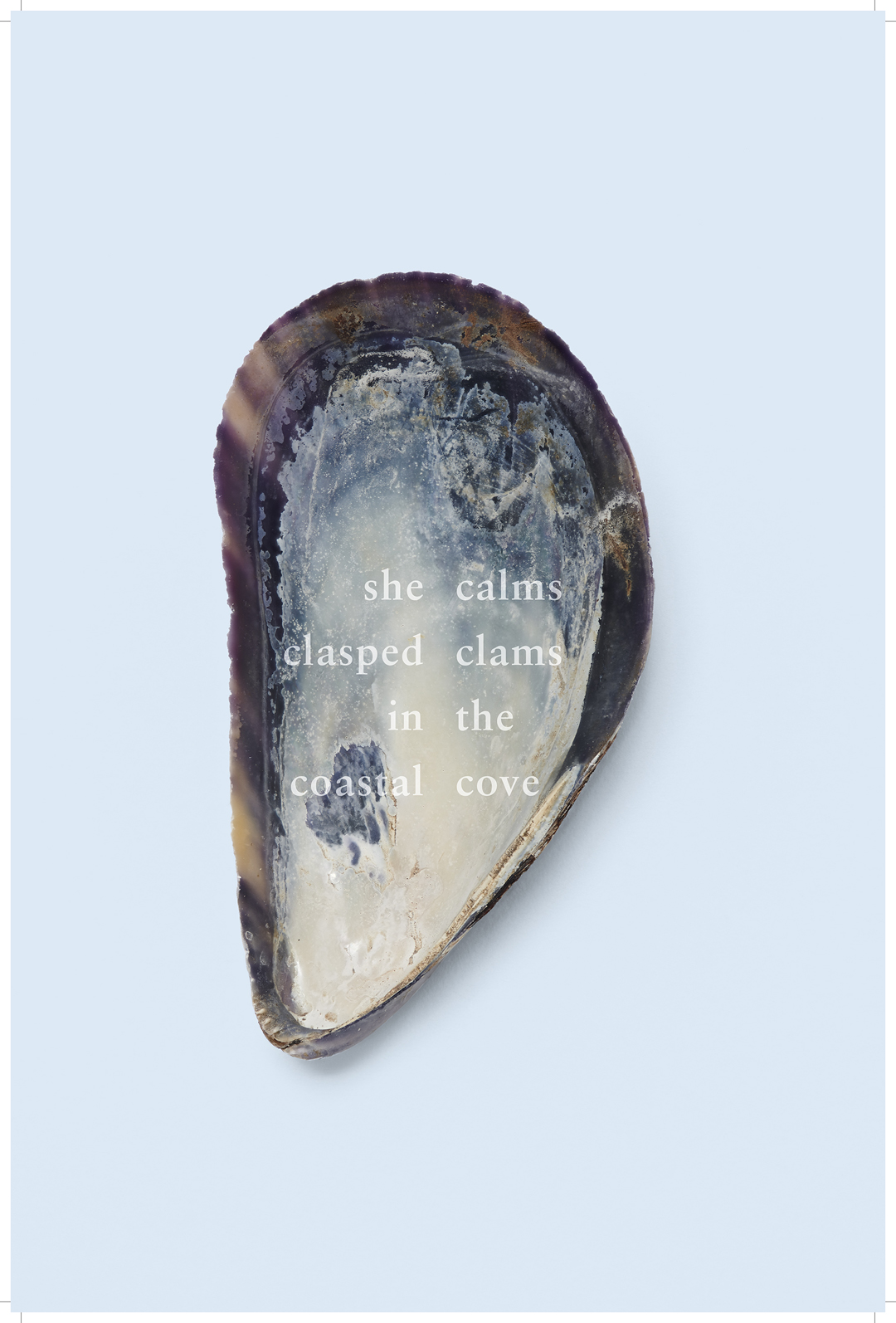
acts of dissent, act 3, 2021-24
lois andisonfine art prints on Hahnemuehle Photo Rag 308, ed. of 5 2AP
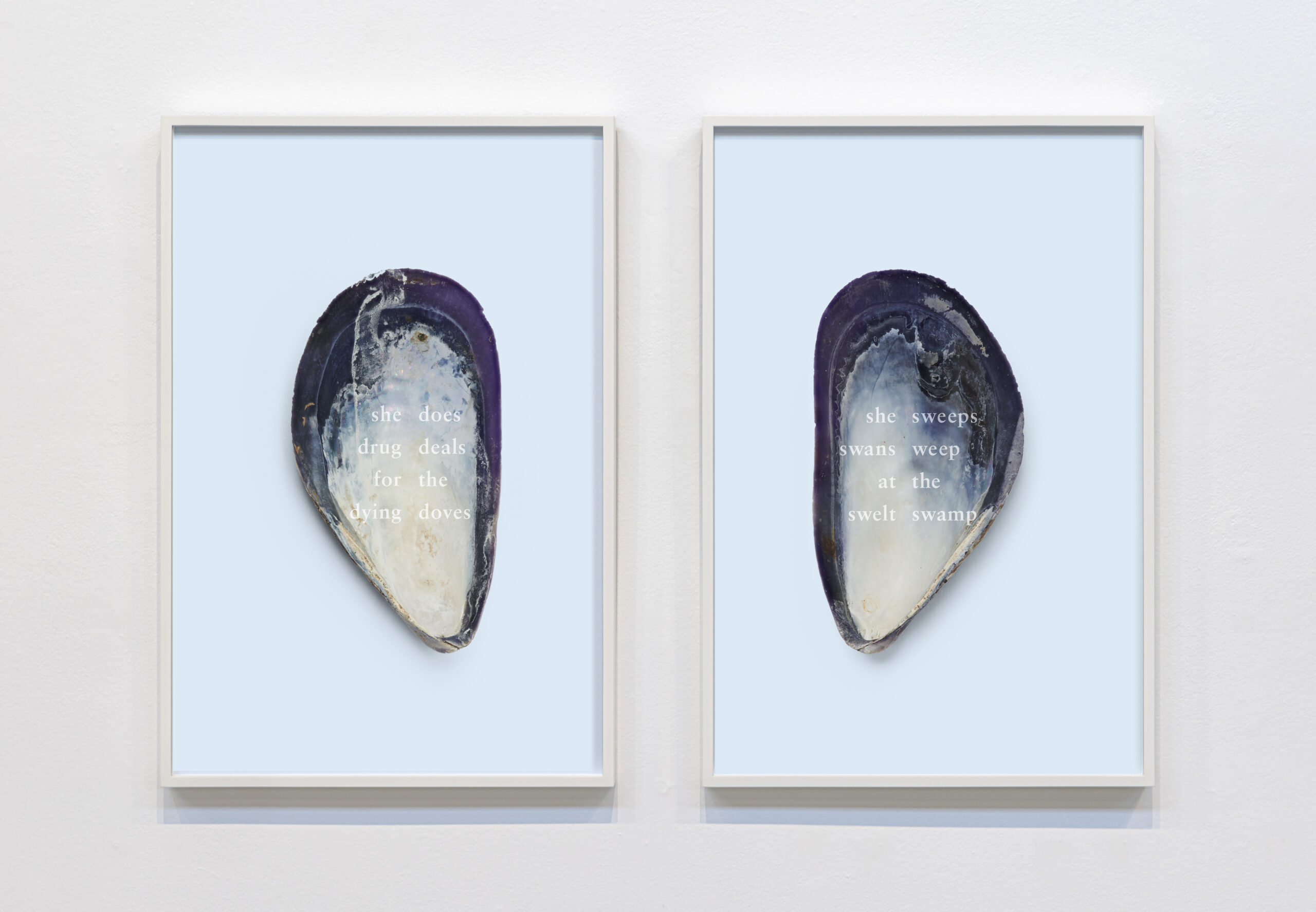

artwork detail
acts of dissent, act 8, 2021-24
lois andisonfine art prints on Hahnemuehle Photo Rag 308, ed. of 5 2AP
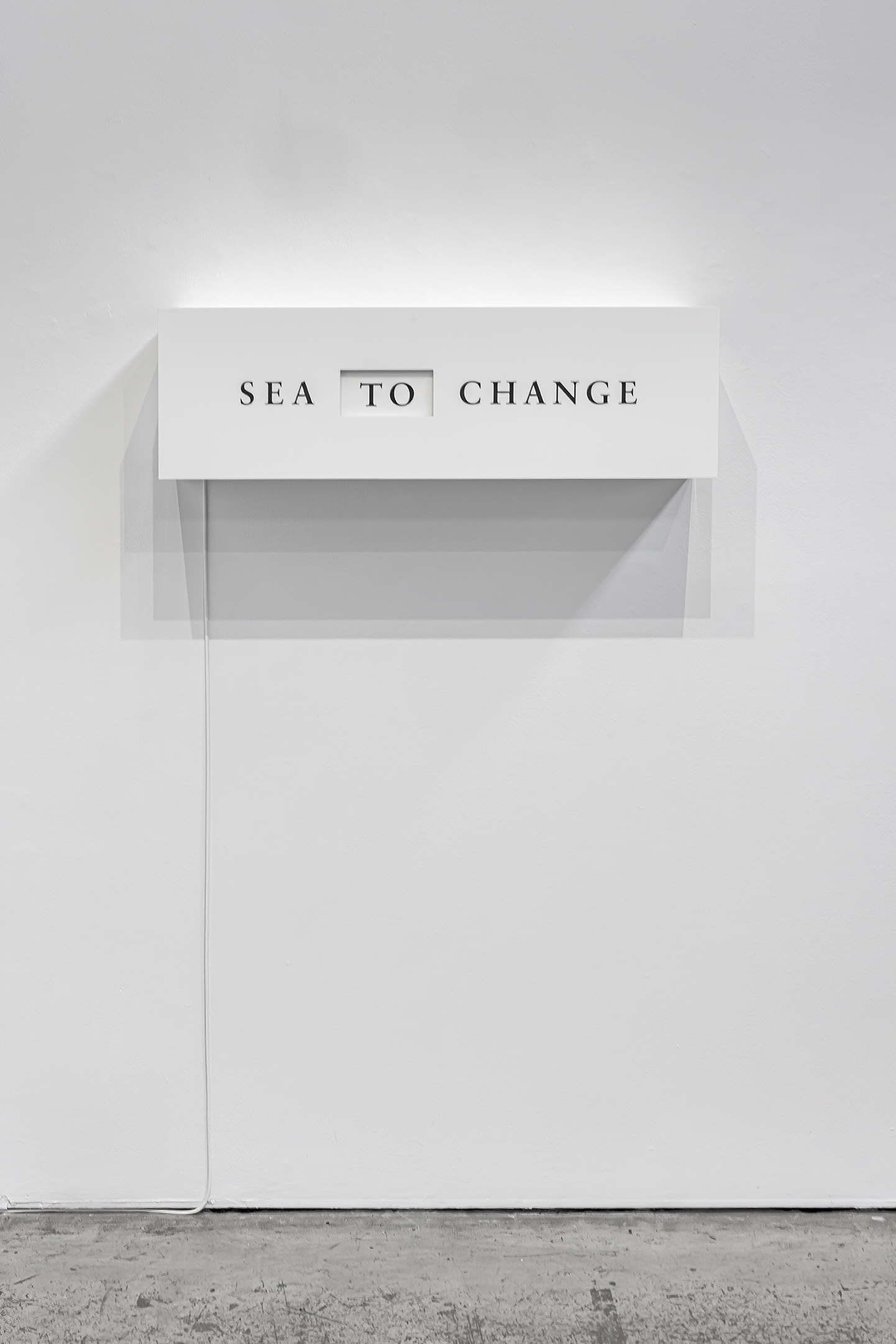
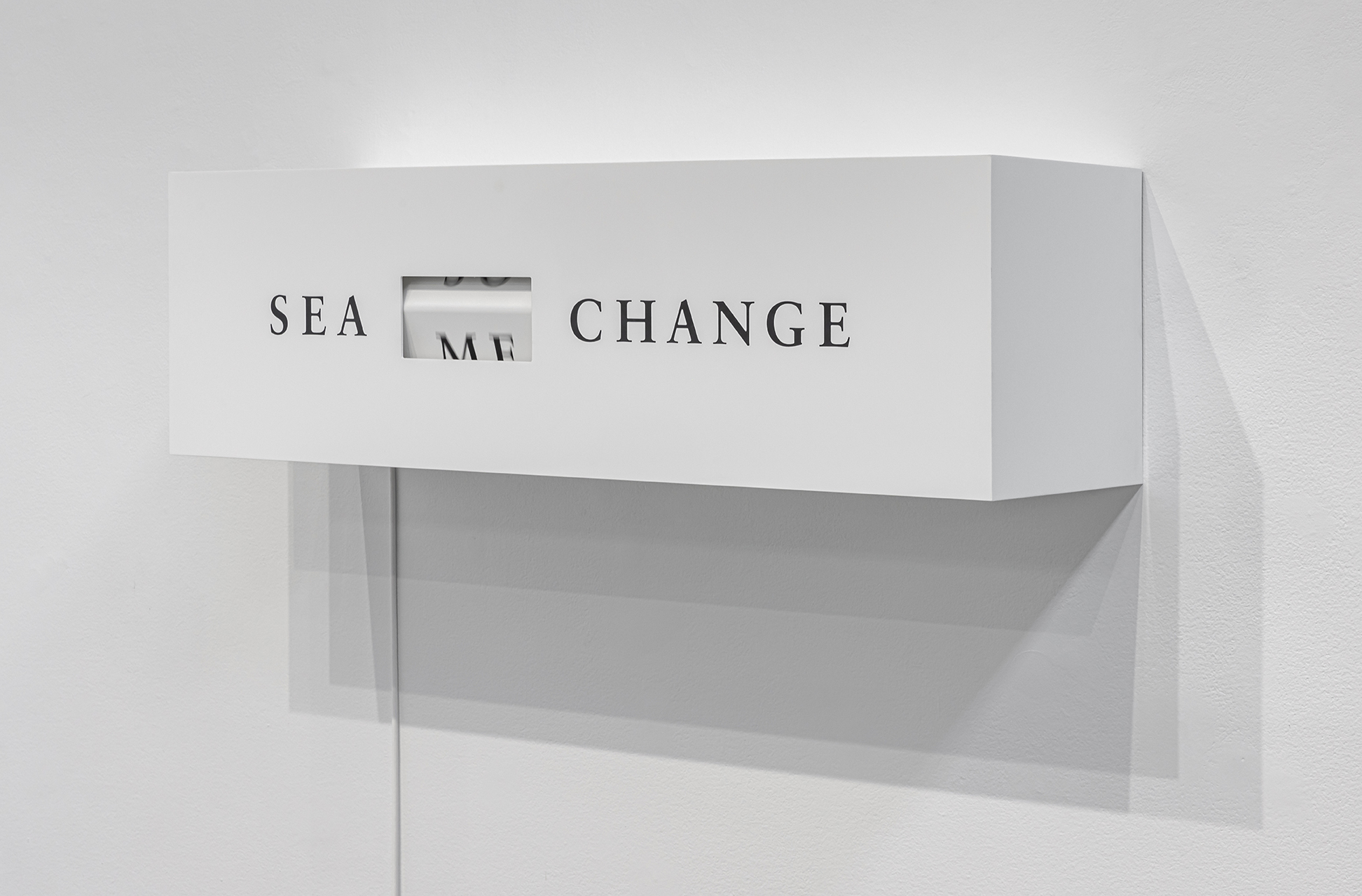
artwork detail
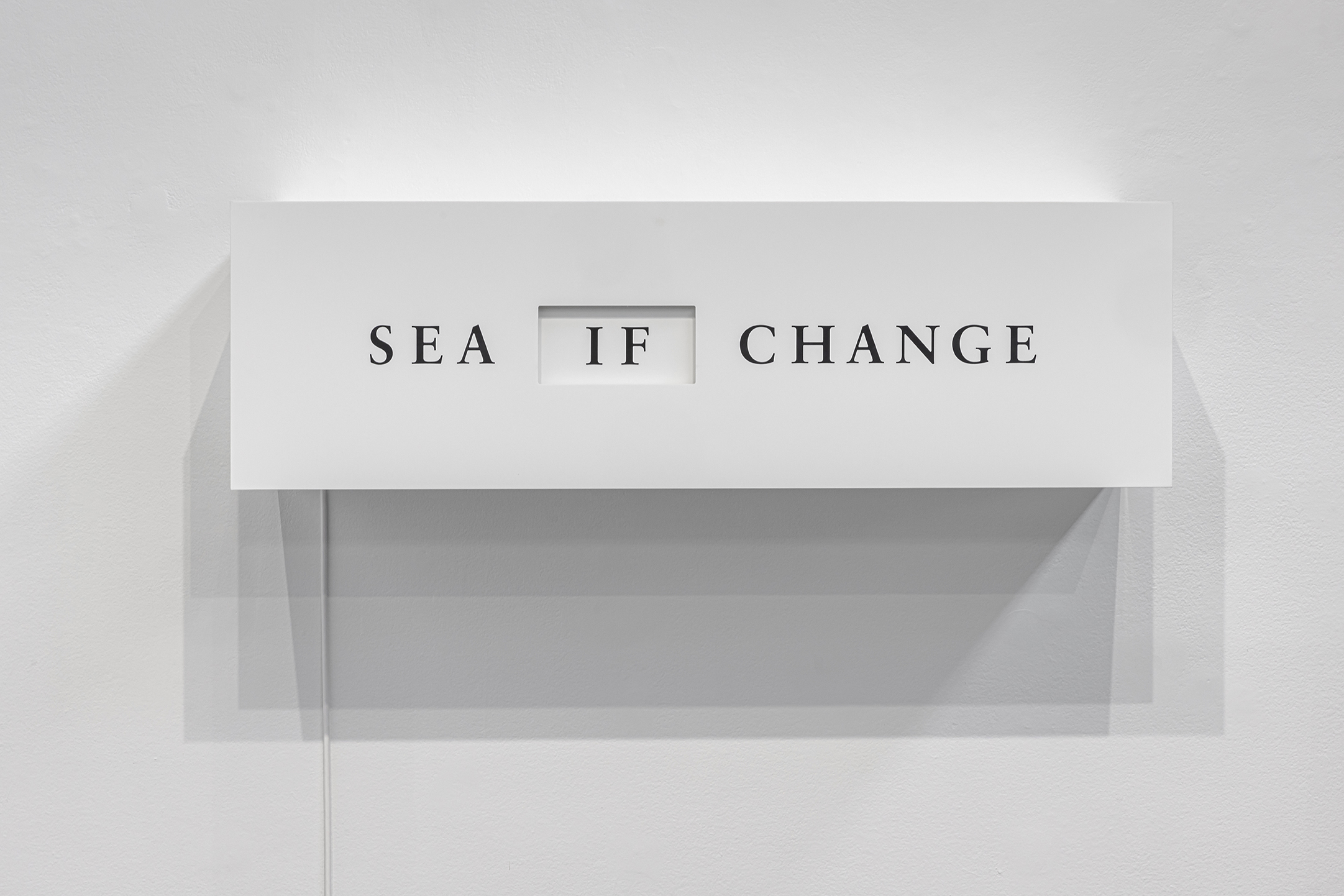
sea to change, 2024
lois andisonacrylic with inlaid text, custom mechanics, and electronics, ed. of 3, 36” x 11” x 11”
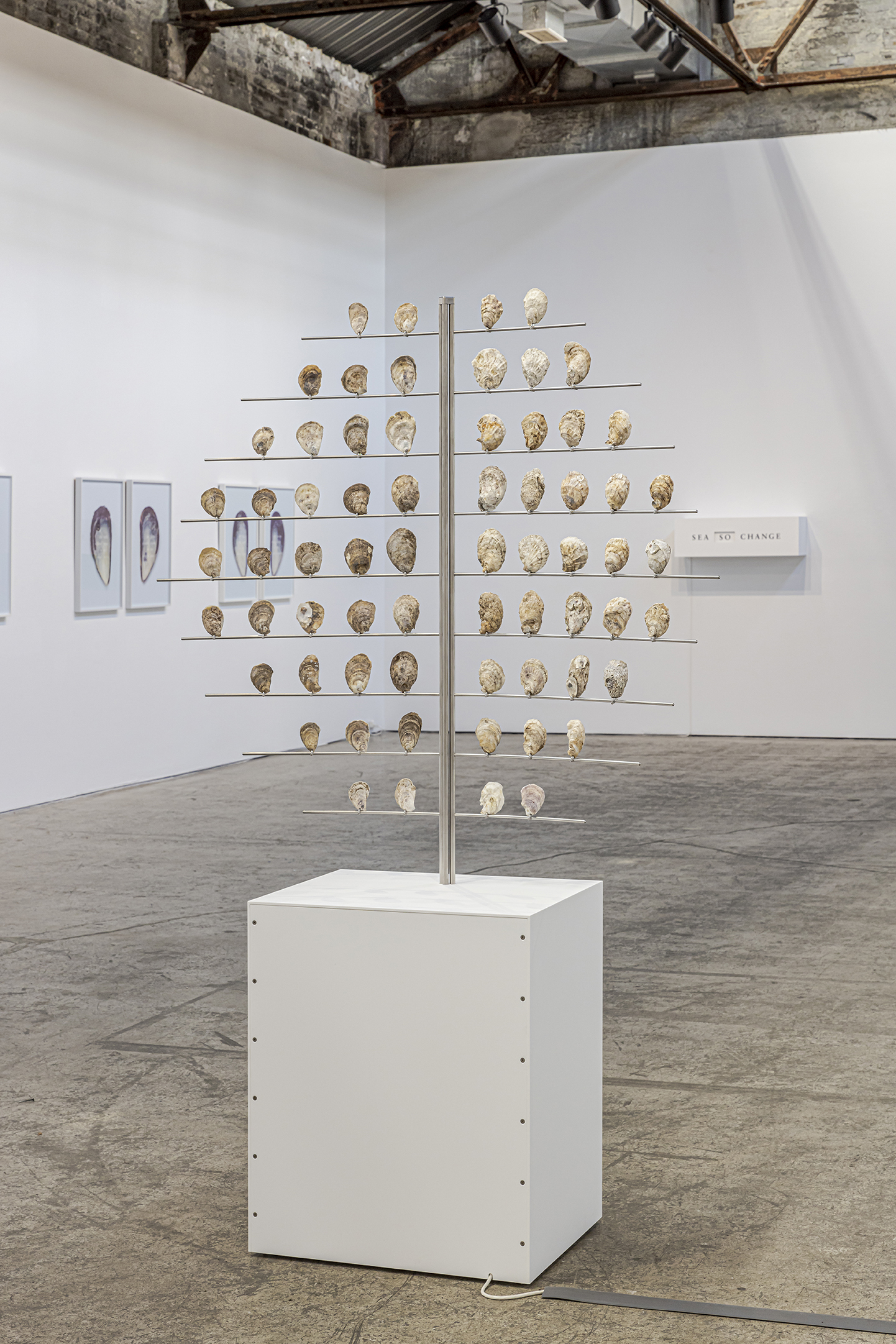

artwork detail
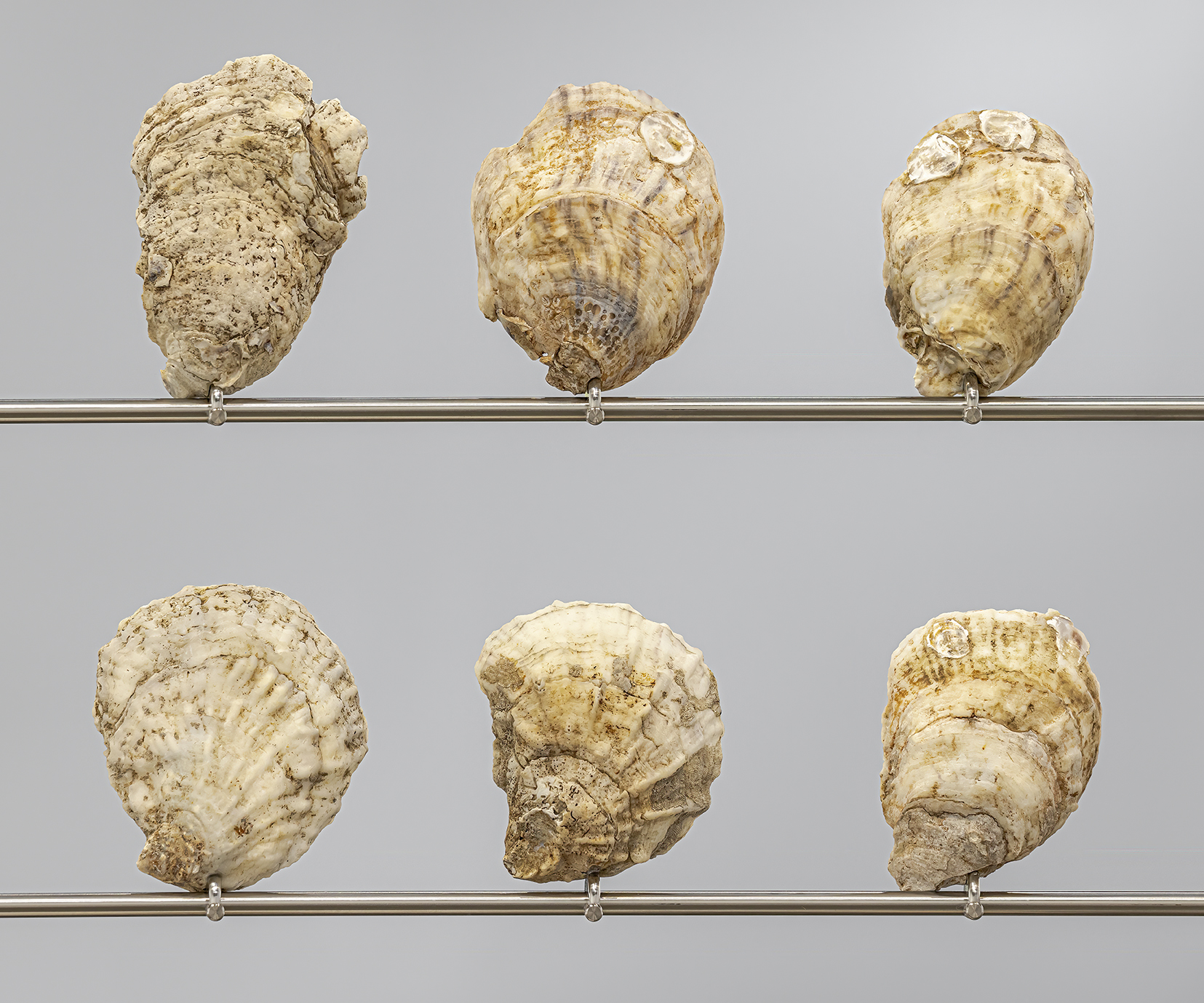
shell shield, 2024
lois andisonexcavated oyster shells, stainless steel rod and shafts, custom mechanics and electronics, acrylic stand, 49.5” x 76.9” x 18”

